64 Thrifted & Vintage Kitchen Trends to Inspire Your Timeless Cooking Space
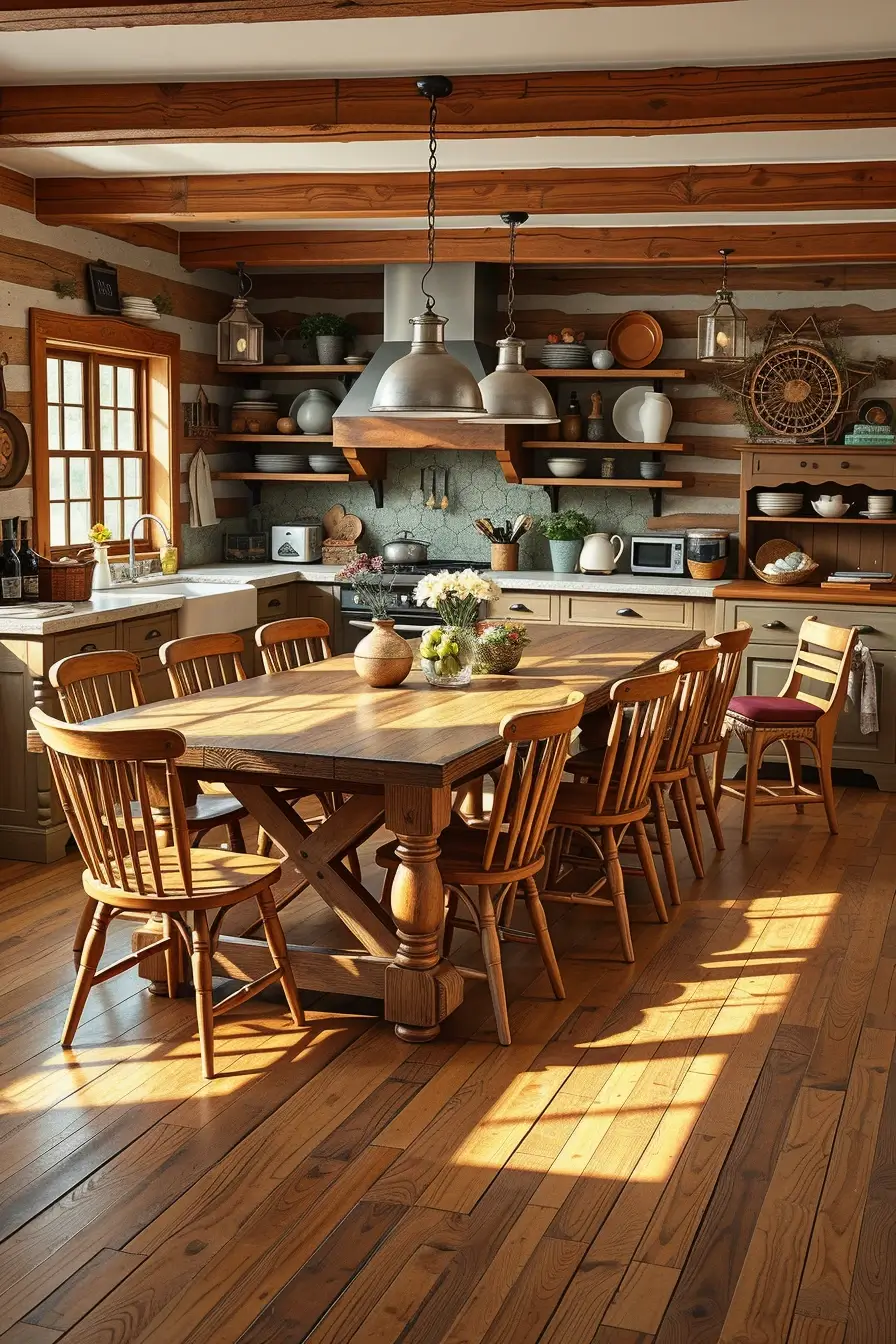
Have you ever wondered why second-hand and vintage kitchen trends are making such a strong comeback in modern homes? In a world where everything seems to be mass-produced, homeowners are turning to pieces with history, craftsmanship, and character to give their kitchens a distinctive edge. In this article, we’ll guide you through the key elements of creating a vintage-inspired kitchen on a budget, from finding retro dish sets to sourcing timeless furniture. I’ll also provide my insights into how these designs not only make a kitchen more beautiful but also more functional and sustainable.
By combining the old and the new, I’ve witnessed kitchens transform into warm and inviting spaces, where every item holds a narrative. Whether you’re interested in mid-century cabinets, colorful Pyrex, or rustic thrifted wood tables, there are endless ways to incorporate these styles into your own home. Let’s explore the world of vintage kitchens and uncover how you can create a stylish and authentic space without breaking the bank.
The Rise of Thrifted and Vintage Kitchen Trends
I believe the beauty of thrifty and vintage kitchen design is that it is authentic. Walk into a room full of mismatched but complementary things and I instantly feel at home. Vintage kitchens are defined by warm wood tones, aged finishes, and accessories that can’t be produced in mass production. This multi-level design not only ensures functionality but also adds a touch of personality, making the kitchen a harmonious blend of purpose and emotion.
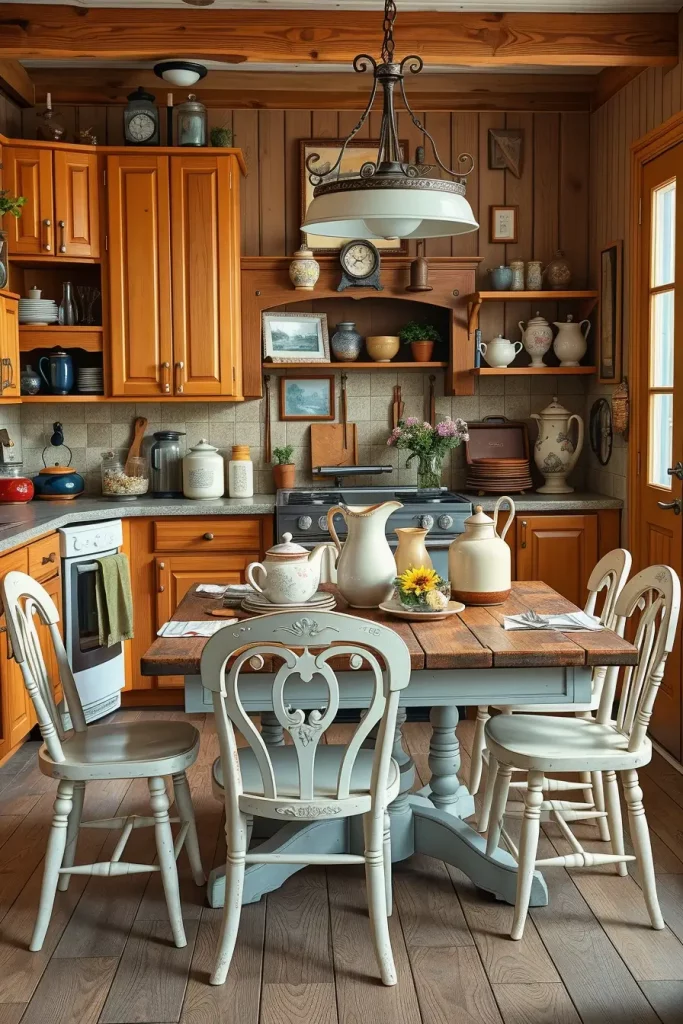
When it comes to thrifty furniture, I look for pieces such as solid wood hutches, old farmhouse tables or even vintage chairs with patinas. The inclusion of smaller accents such as ceramic pitchers, glass jars, or metal bread boxes adds subtle accents that bring the look together. Each piece is practical but also a story in the room.
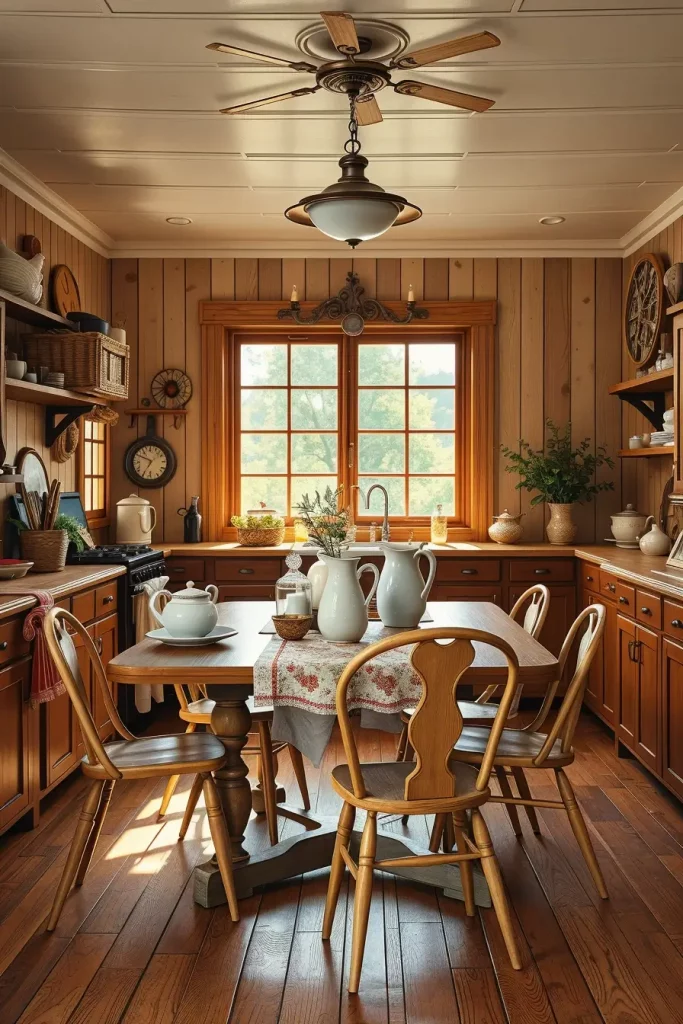
I’ve found that incorporating thrifted pieces into my kitchen has always inspired creativity. Interior designers cited in Architectural Digest are quick to point out that kitchens shouldn’t be sterile-they need to be a reflection of life, family and tradition. By curating vintage treasures, I can create a layered and unique look that leaves a lasting impression on my space.
What I would add here is the need for balance. If you have a lot of small items, the kitchen can look cluttered very quickly. I suggest you pick a few powerful vintage statements and let them stand out against a more neutral background.
Combining Old with New For A Balanced Kitchen Aesthetic
Mixing vintage with contemporary is a way to achieve balance, and I think this is one of the best kitchen design tricks. Too much of either can be overbearing or chilly. The combination creates an atmosphere that is cozy and yet functional for daily living. For instance, a combination of sleek countertops and a thrifted wooden island can create a harmonious blend of functionality and character.
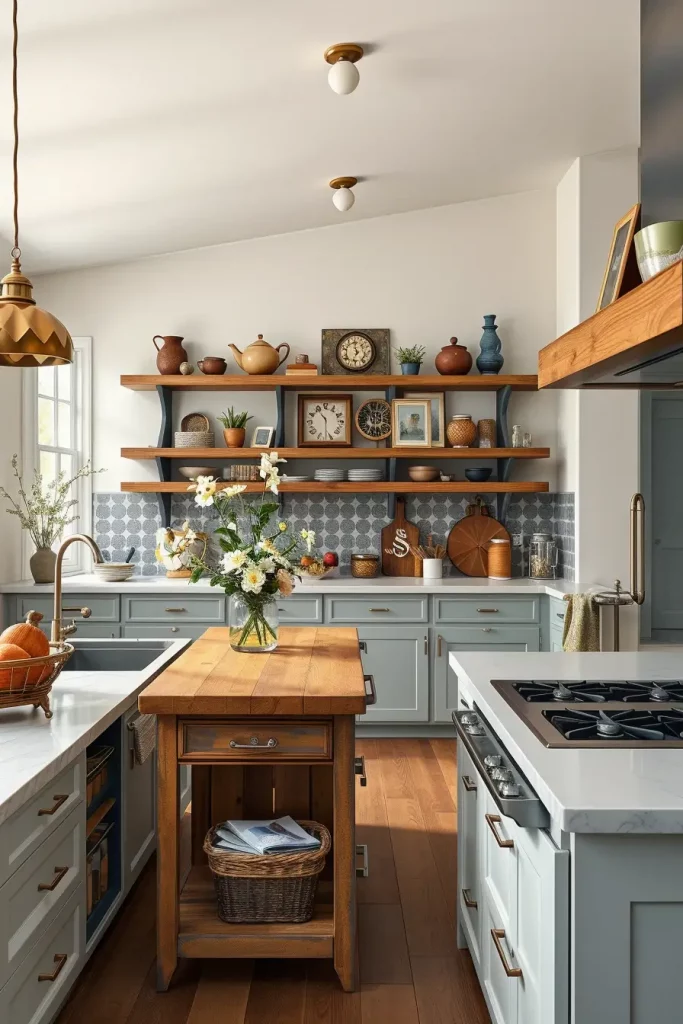
I like to use modern appliances but tone them down with vintage cabinets or open shelving. A reclaimed wood dining bench or thrifted dining stools paired with a modern table creates a functional and unique space. This way I don’t sacrifice convenience, while still keeping the kitchen warm and cozy.
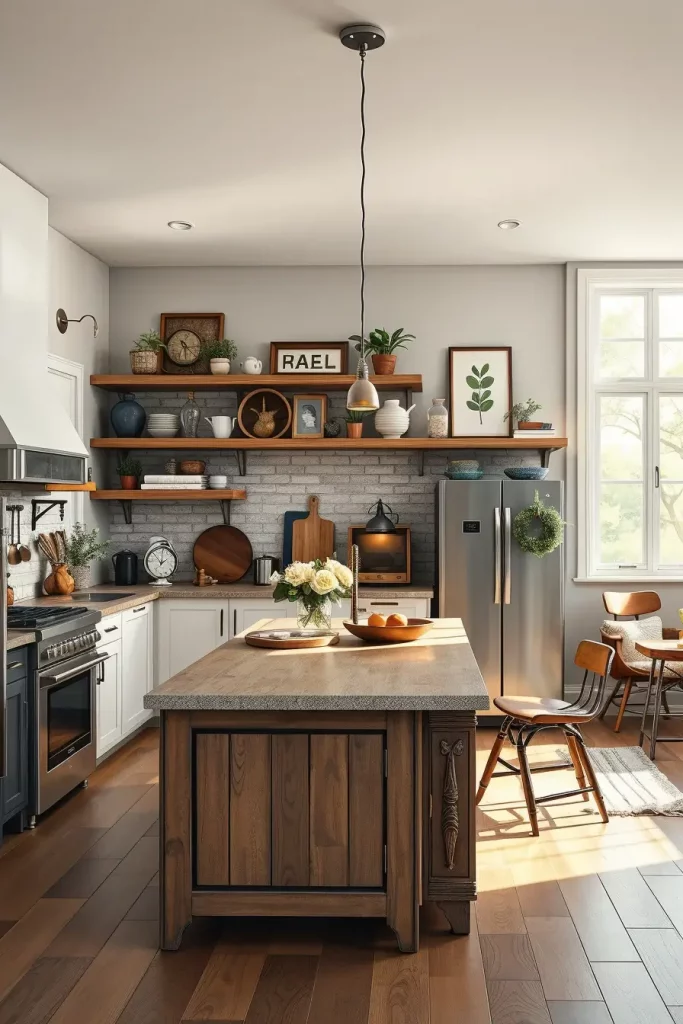
From my experience, homeowners that embrace this mix often feel more comfortable in their kitchens. According to Better Homes & Gardens, the trick is moderation: don’t fill the room with either extreme. Pick focal pieces that set the tone, and then accentuate with more subtle accents.
I would also add a suggestion here: use neutral paint colors on the walls to tie the mix together. This way, the modern and the vintage elements work together, and the kitchen appears cohesive rather than cluttered.
The Elegance Of Vintage Kitchen Cabinets
I have always loved vintage kitchen cabinets because they have character that new can’t. Their designs – with glass fronts, recessed panels, or charming patina from decades of use – lend instant depth. I find they also remind us of a time of slower times, when kitchens were built with strength and care.
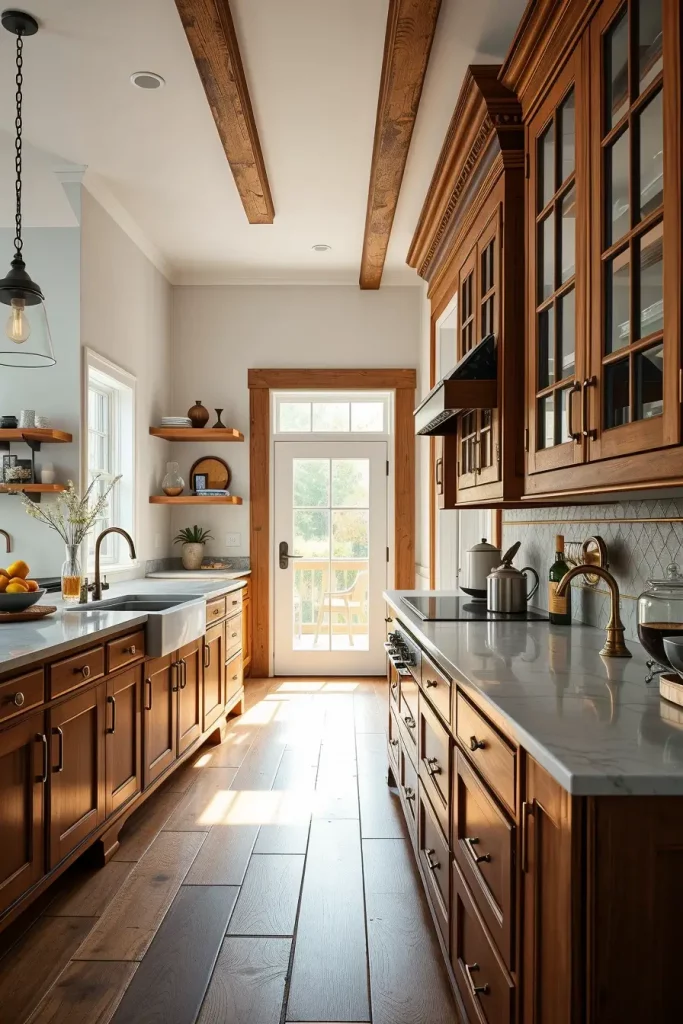
Not only is reclaimed or thrifted cabinets a cost-effective choice, but they also add a touch of craftsmanship to your design. For example, cabinets with vintage brass handles or painted wood accents provide an element of authenticity. I prefer cabinets that have been gently restored to keep their charm, while still working for modern use.
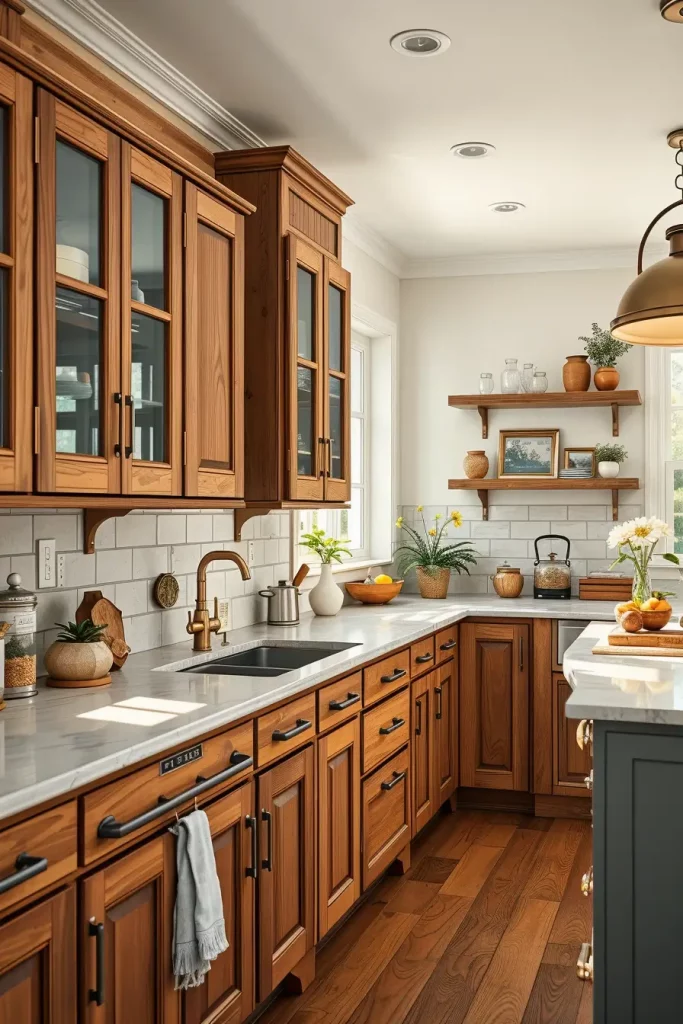
In my own work, I’ve found that cabinets are usually the first thing that people notice. As House Beautiful notes, cabinets are the focal point of any kitchen decor. Vintage pieces can ground the room with warmth, history, and uniqueness.
One more option that I would include here is the possibility of combining original vintage cabinets with modern inserts (drawers, pull-out systems, etc.) to maintain convenience while preserving this timeless beauty.
Retro Appliances Restoration of Traditional Design
Retro appliances are coming back in vogue, and I think they’re a fun yet functional addition to an old kitchen. Brands today make refrigerators, ranges, and mixers that are reminiscent of mid-century style but with modern technology. I find this nostalgic design and modern function balance incredibly useful.
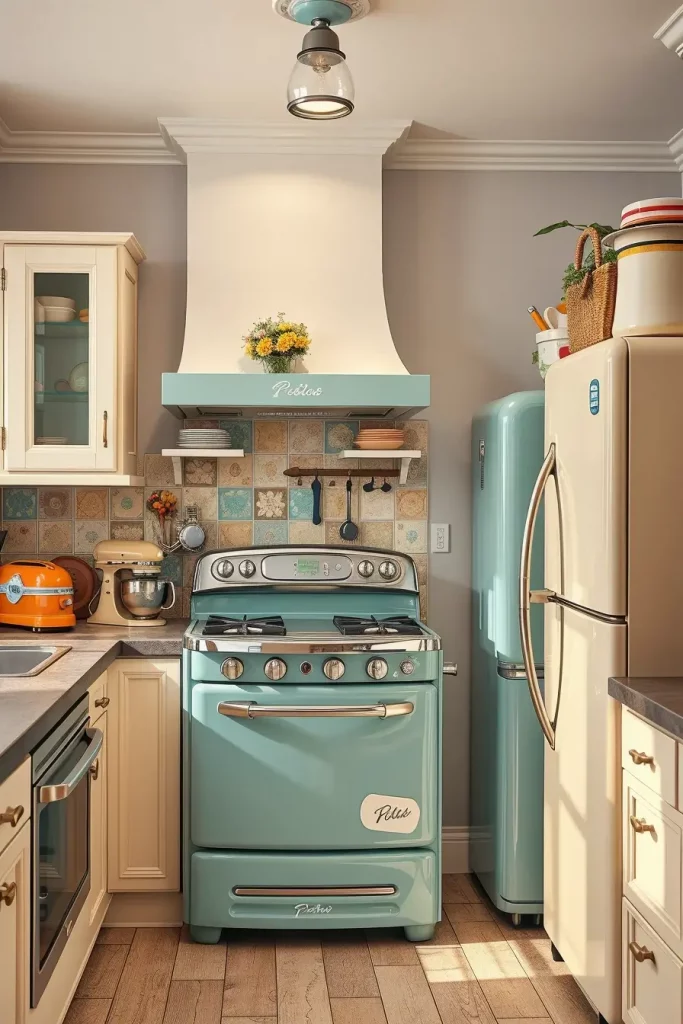
When I pick appliances, I look for those with curved edges, chrome accents or pastel colors. These are great focal points in the kitchen and are an instant indicator of a retro ambiance. Even a single object, such as a mint-green refrigerator, can change the atmosphere.

In my opinion, retro appliances also make cooking more fun because they make the kitchen happy. Often, Elle Decor points out that design should bring joy to everyday life and retro appliances do just that. They recall the past while providing the assurance of the present.
If I had to take this further, I would include small retro accessories like a toaster or kettle to go with larger appliances. This consistency ensures the theme is not overpowering the space.
Farmhouse Tables And Thrifted Dining Charm
A farmhouse table is one of the focal points I tend to suggest in a thrifty or vintage kitchen. These tables are a symbol of warmth, hospitality and tradition. Their large size and durability make them useful, and the aged wood gives them character. To me, this combination is timeless and very alluring.
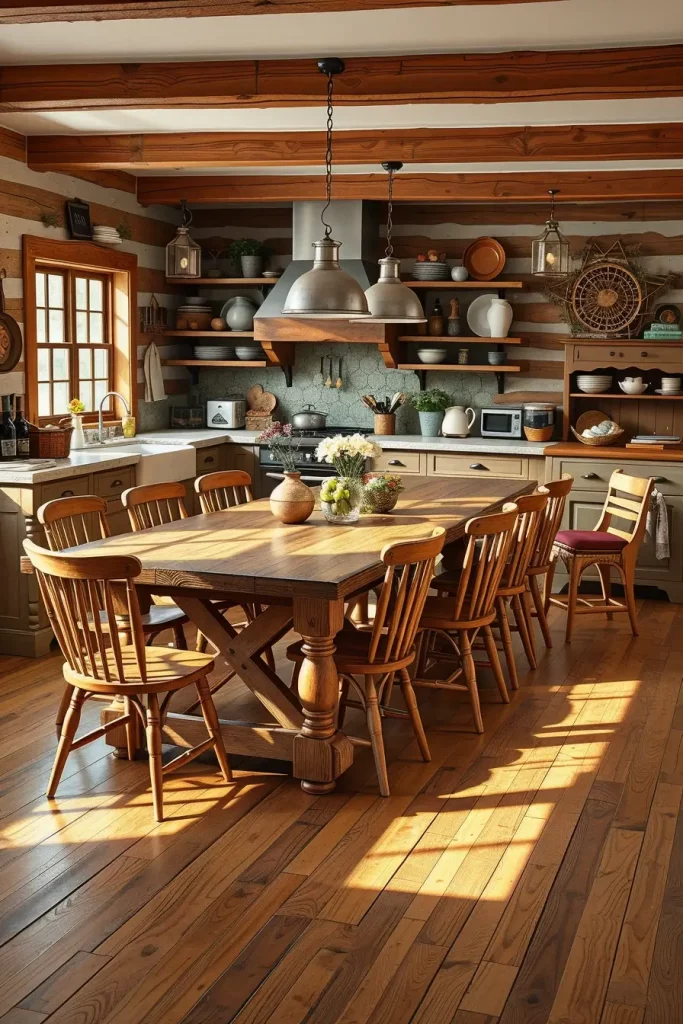
When I choose one, I look for solid oak or pine tables with signs of wear. Mismatched chairs are even cuter when they are mismatched thrifted seating. A farmhouse table fits just as well in small kitchens or large dining rooms, and in every case, it creates a gathering place.
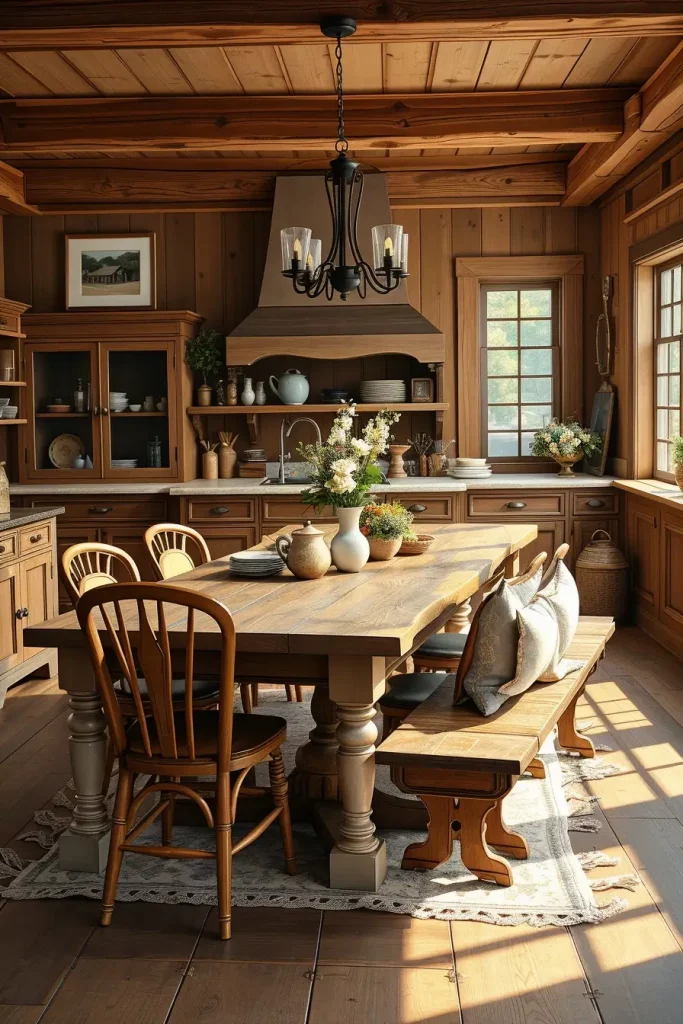
I personally love how these tables ask for connection. Designers in Country Living explain that farmhouse tables have a “lived-in” quality that makes kitchens feel inviting. They’re a must because guests will naturally gravitate to them.
If you’re looking for an example, I would suggest combining a farmhouse table with a thrifted bench. It’s space-saving, seating options are flexible, and it works well with the rustic style.
Vintage Hardware As A Kitchen Feature
Sometimes it’s the little things that make the most difference. I think vintage hardware (drawer pulls, knobs, hinges) is a simple and inexpensive way to add vintage style to a kitchen. These details are frequently overlooked but can make a difference to the overall appearance of cabinetry.
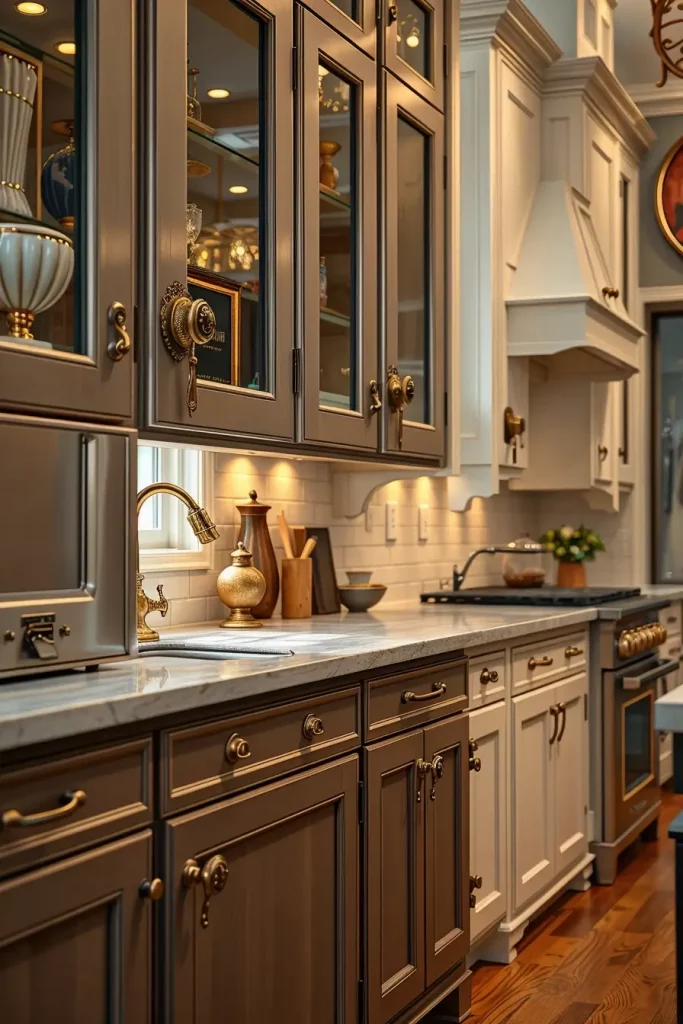
I usually use brass, bronze or ceramic knobs from flea markets or thrift shops. Their patina is a story-teller and they look amazing against modern cabinetry finishes. Not only are they decorative, but antique hardware is durable and will often outlast mass-produced hardware.
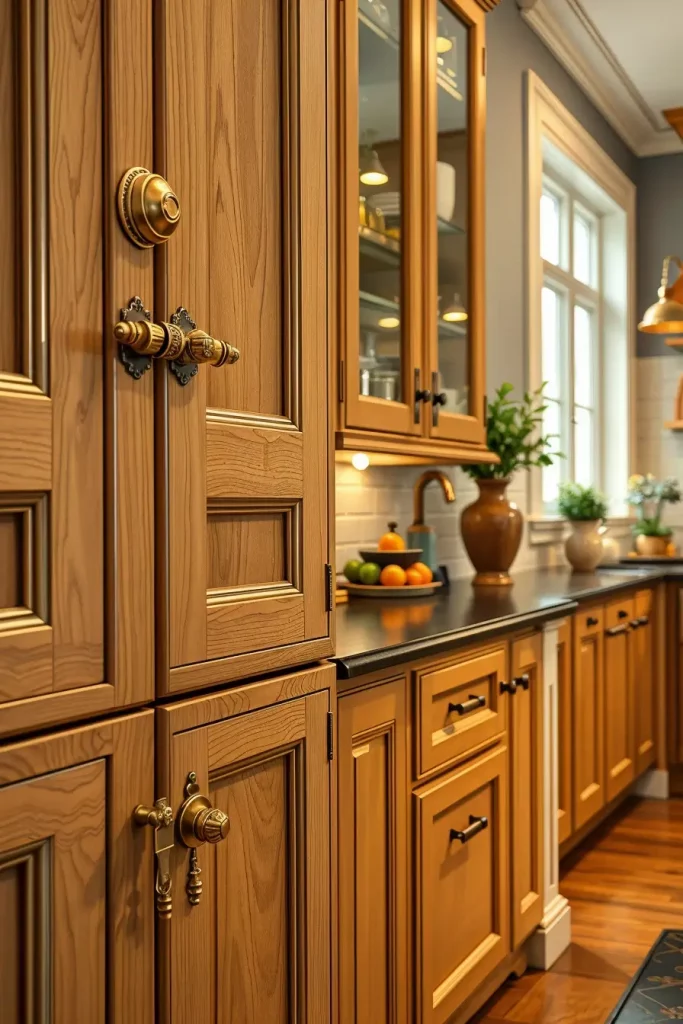
In my own designs, hardware always leads to discussion. Martha Stewart Living states that small accents often shape a room’s character, and I couldn’t agree more. Antique handles or hinges add even plain cabinets a touch of individuality.
What I would add here is that it’s important to mix finishes carefully. Metals can be overwhelming, so I recommend using one or two finishes in the kitchen to maintain a cohesive look.
Thrifted Everyday Tableware
Dinnerware is a small but influential component of a vintage kitchen. I’ve discovered that thrifted sets (usually mismatched) add character and color to daily meals. A floral plate, a ceramic cup or enamel bowls are enough to bring charm.
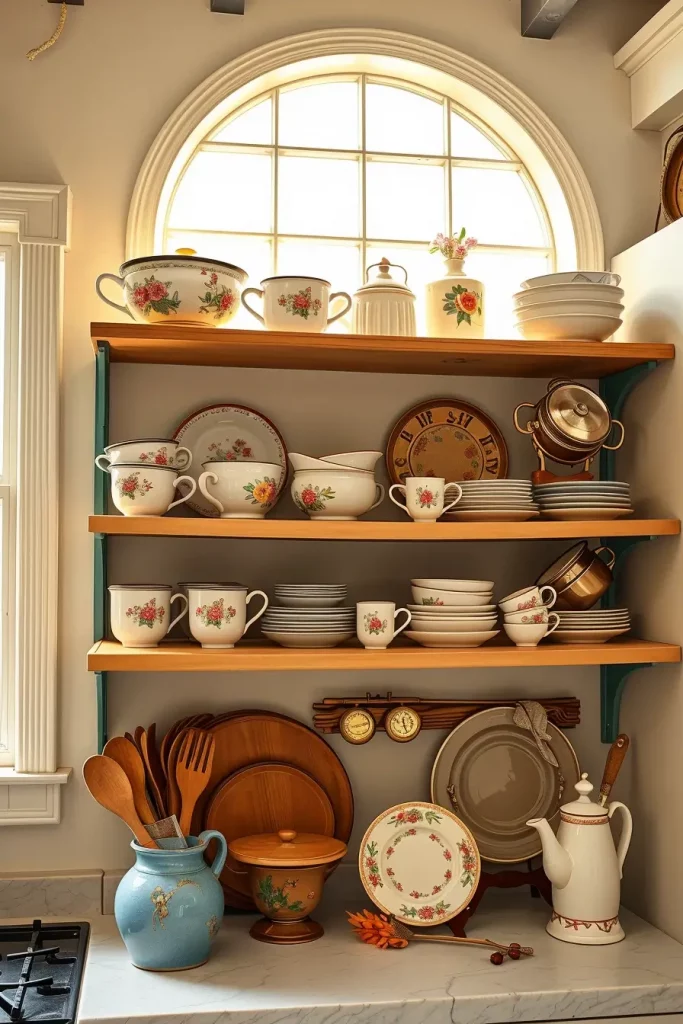
When I thrift dinnerware, I look for durability and style. Mixing patterns is half the fun but I make sure the items are practical enough to be used daily. Open shelving or glass-front cabinets allow these collections to be displayed while still being useful.
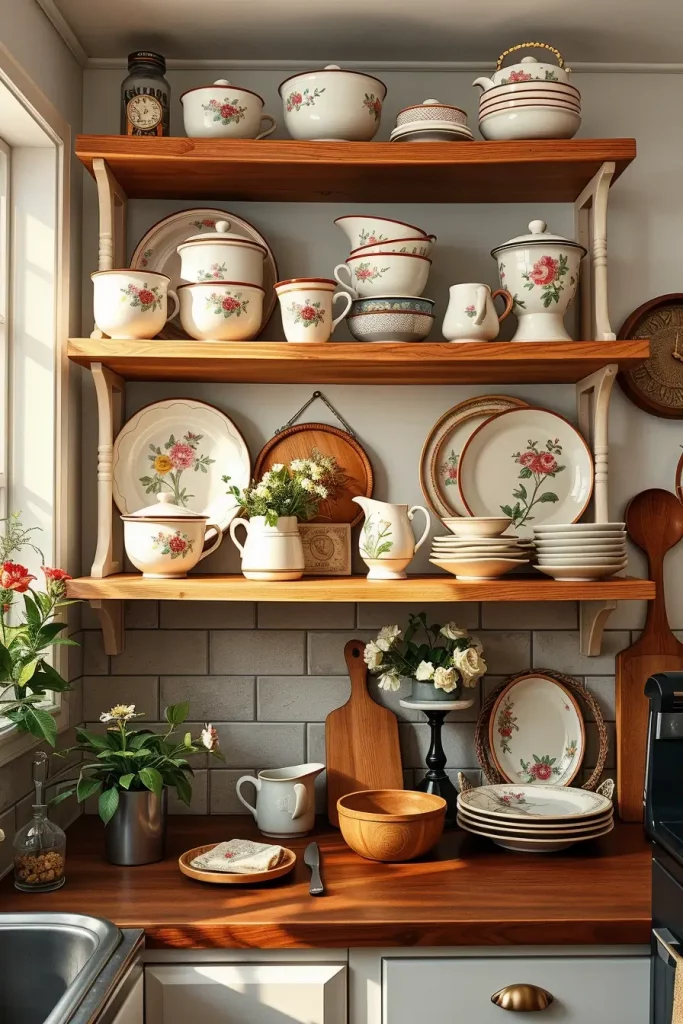
Personally, I love to use thrifted dinnerware because it makes regular days feel special. Good Housekeeping has often reported that small design details make a big difference, and dinnerware is just that sort of detail in the kitchen.
If I were to expand this, I’d include the concept of seasonal rotations. Different sets can capture the mood of the season and keep the kitchen visually fresh all year round.
Antique Glassware and Crystal Jewels
I think that old glassware and crystal pieces can instantly give a vintage kitchen. These pieces infuse a sparkle, an air of refinement, and a touch of sophistication that complements the rustic charm of thrifted furniture. Clear glass is very good at catching the light, making even a small kitchen look brighter and more welcoming. I find this particularly useful in kitchens that are low in natural light.
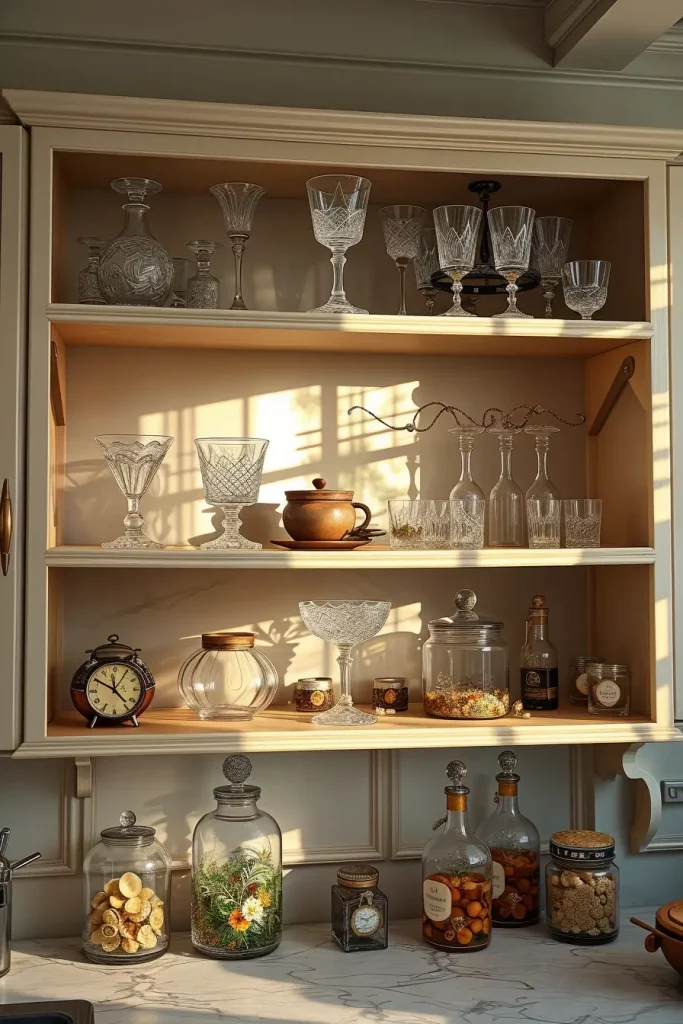
When I shop for thrifted glassware, I look for crystal goblets, etched glasses or even plain clear jars. These are great for everyday wear and for display as well. They can be placed on open shelves or in glass-front cabinets to add sophistication to the space. Crystal bowls or decanters can also be used as statement pieces in the dining area.
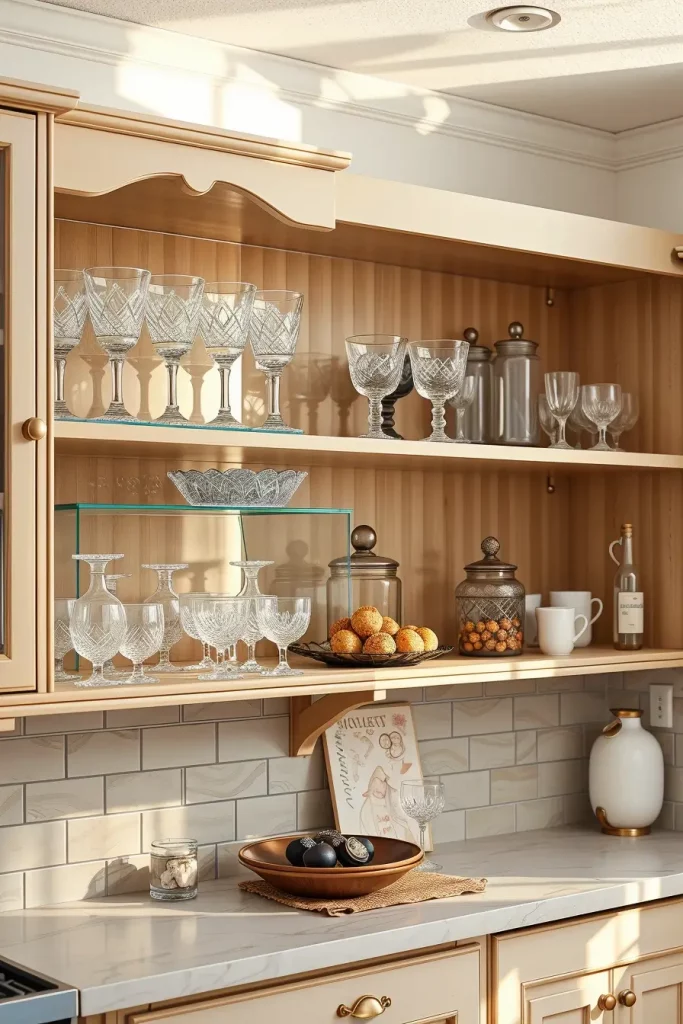
From my point of view, these little details make the kitchen feel more special. Veranda magazine reports that crystal and glassware can change the atmosphere of a room, providing a celebratory feeling even in the most ordinary moments. I’ve seen the same effect in kitchens I’ve designed.
What I would add here is the importance of combining solid, everyday glassware with special vintage finds. This keeps the kitchen both useful and beautiful while not being too delicate for everyday life.
Vintage Statement Lighting With A Modern Glow
Lighting is one of the most important design decisions, and in my experience, fixtures inspired by the past add incredible charm. A chandelier over a farmhouse table or a set of retro pendant lights over an island instantly gives character. I find that lighting also makes the combination of old and new elements work together well.
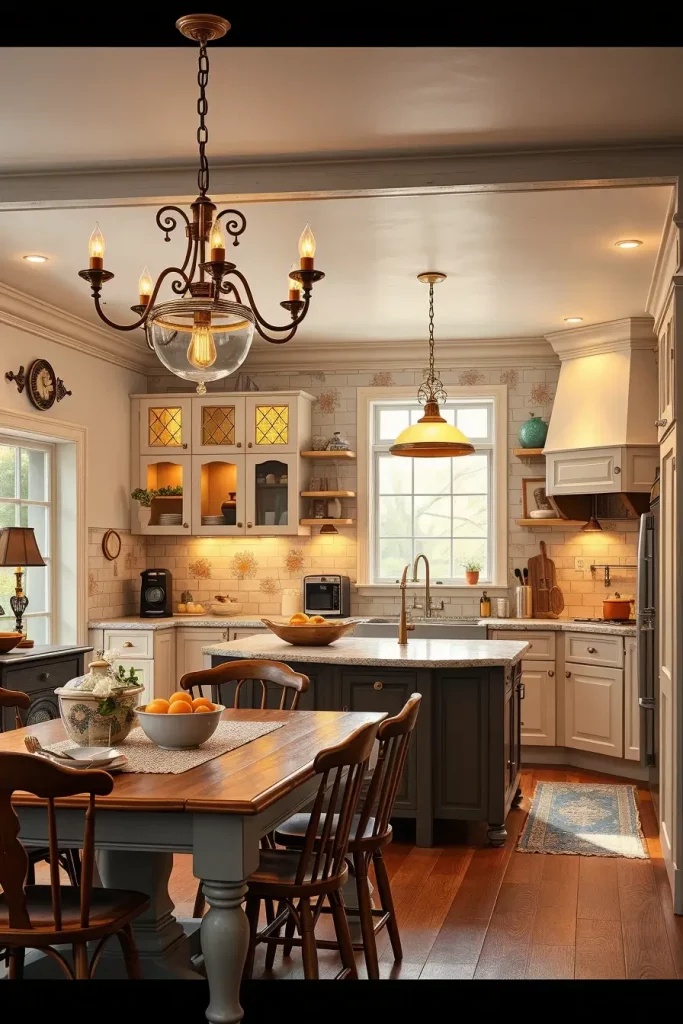
When thrifting, I look for brass chandeliers, enamel pendants or industrial style sconces with patina. Rewiring is often a must, but the end result is worth it, as these pieces become focal points in the kitchen. Small lamps on sideboards can add to the cozy atmosphere.
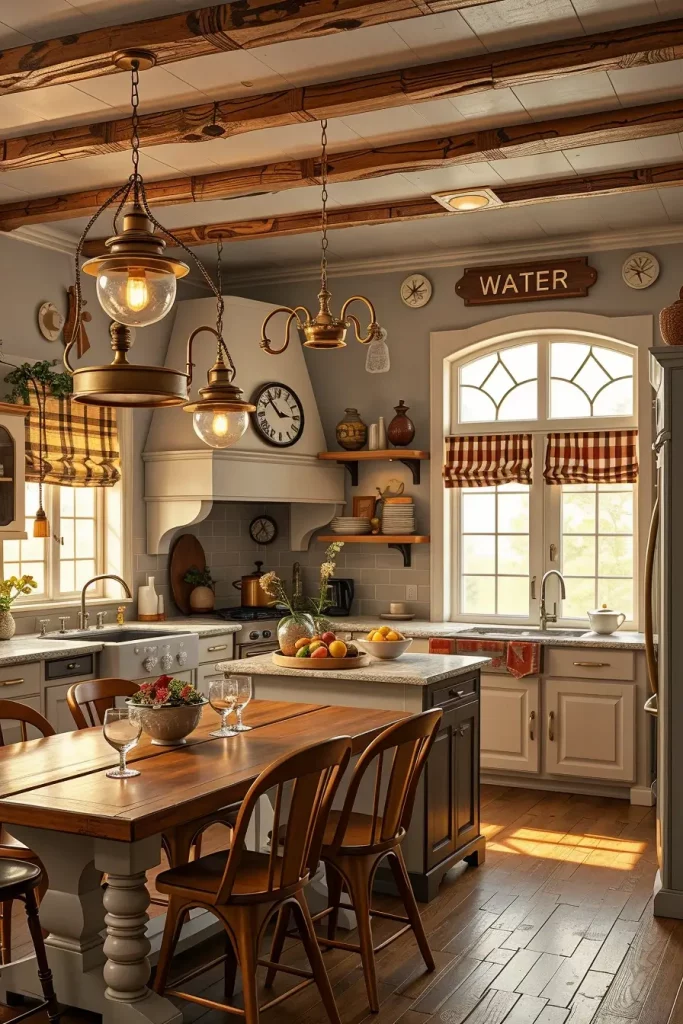
I think vintage lighting also has an emotional warmth. According to Architectural Digest, vintage pieces lend themselves to the task and ambient light balance, which is achieved by layering lighting designs. I frequently use dimmable bulbs in old fixtures to bring their function into the modern era.
Here, I’d add that mixing fixture styles (such as one bold chandelier with simpler sconces) prevents the room from feeling overdone. It’s all about balance and cohesion.
Vintage Treasures Style Open Shelving
Open shelving is a great way to display thrifted and vintage treasures. I’ve found that shelves of dinnerware, cookbooks or small kitchen antiques make the room interesting without cluttering it up. They provide the essentials for everyday life while letting personality shine.
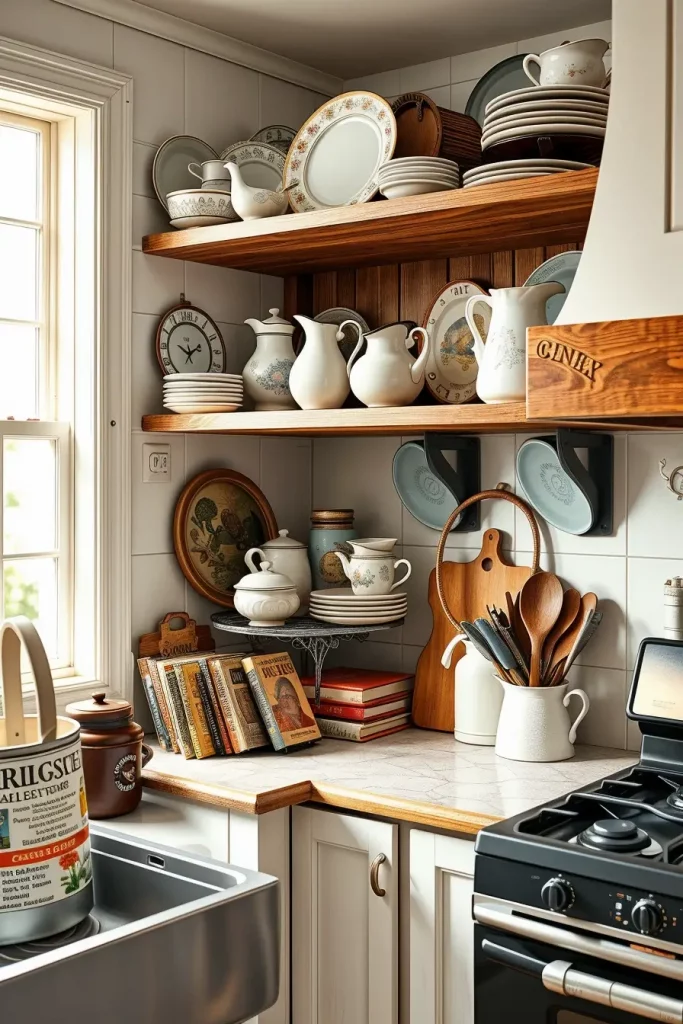
When decorating shelves, I tend to use a combination of functional items such as plates and mugs with decorative accents such as enamel pitchers or vintage tins. The aged wooden shelves add a perfect look to the design. The trick is to organize them strategically-large items to the center and smaller pieces around them.
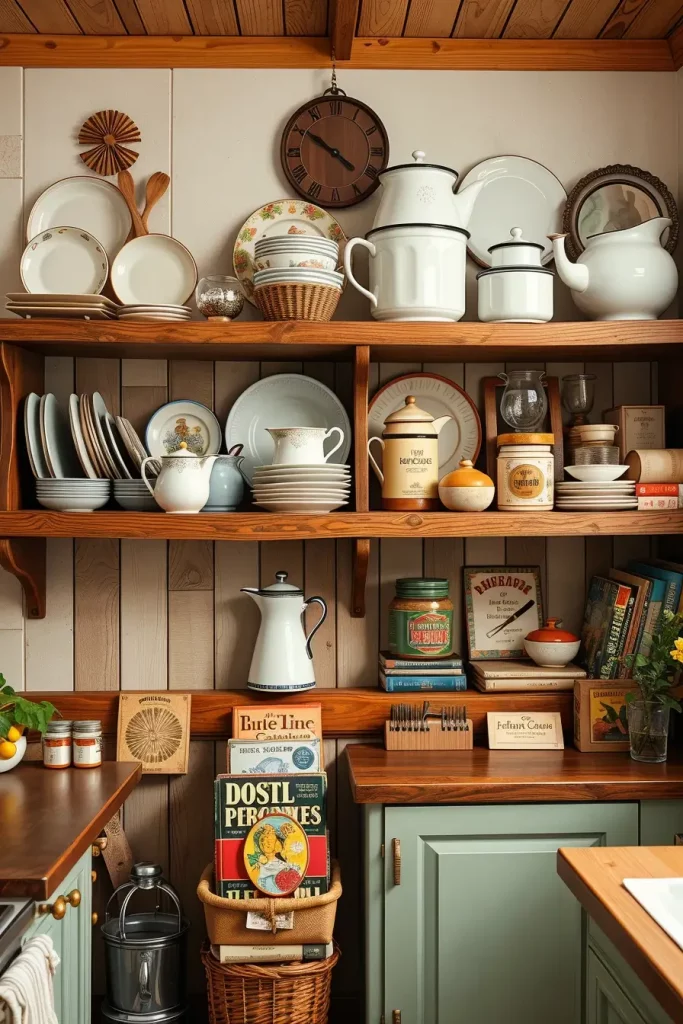
From my point of view, open shelving is a way to bring life to the kitchen. Better Homes & Gardens often suggests this method because it can be changed up seasonally or whenever you find new thrifted finds. It gives the design the freedom to evolve over time.
What I would add here is that some negative space is important. The few empty spaces make the display seem curated rather than cluttered, which adds to beauty and functionality.
Repurposed Furniture For Kitchen Storage
Thrifted furniture is one of my favorite ways to create a thrifty kitchen. Old dressers, hutches or sideboards can provide useful storage and add character. I also think these pieces are less wasteful by giving furniture a second life, which is very much in line with sustainable design values.
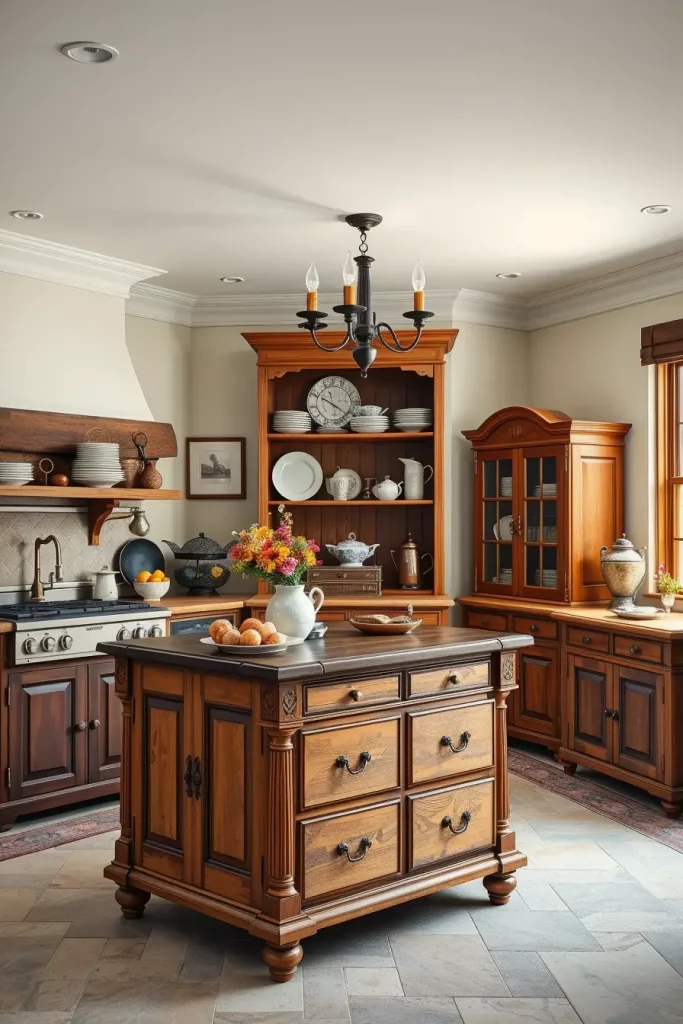
When choosing a piece, I look for good construction and plenty of drawers or cabinets. A dresser can be used as an island, and a hutch can be used to store dishes and cookware. Even a small side table can be used to store utensils or pantry items and add a touch of uniqueness to the kitchen.
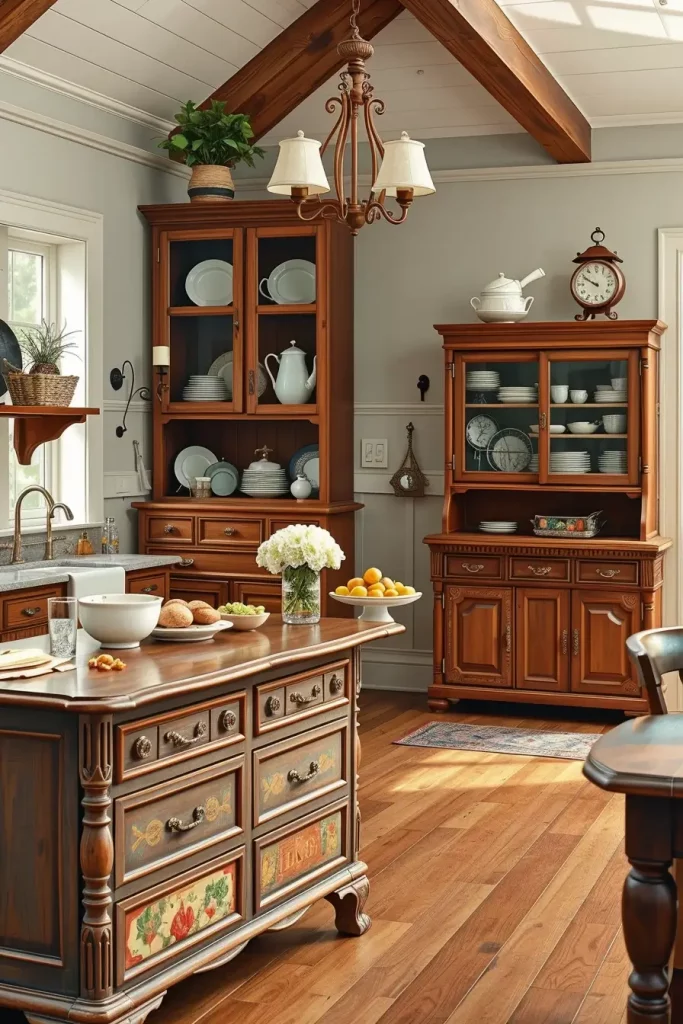
I’ve personally turned a thrifted wardrobe into a pantry cabinet, and it’s the most complimented piece in the space. Repurposing is a common theme in Country Living and Country Living experts often remind homeowners that the kitchen doesn’t have to be limited to built-ins for storage.
What I would add here is to make sure repurposed pieces are well sealed or refinished, especially if it will store food. This makes them both safe and practical.
Historical Period Color Schemes
Color can make a significant impact on the feel of a kitchen, and vintage palettes are making a comeback. I am inspired by soft pastels, vibrant vintage colors and earthy farmhouse tones. These colors not only evoke nostalgia but also bring warmth and identity to the space.

I frequently use mint greens, butter yellows or robin’s-egg blues for a cheerful 1950s vibe. For a farmhouse-inspired color scheme, I use warm creams, earthy browns and muted sage greens. Retro kitchens, on the other hand, look good in strong reds, blacks and whites. The palette is responsible for the whole atmosphere.
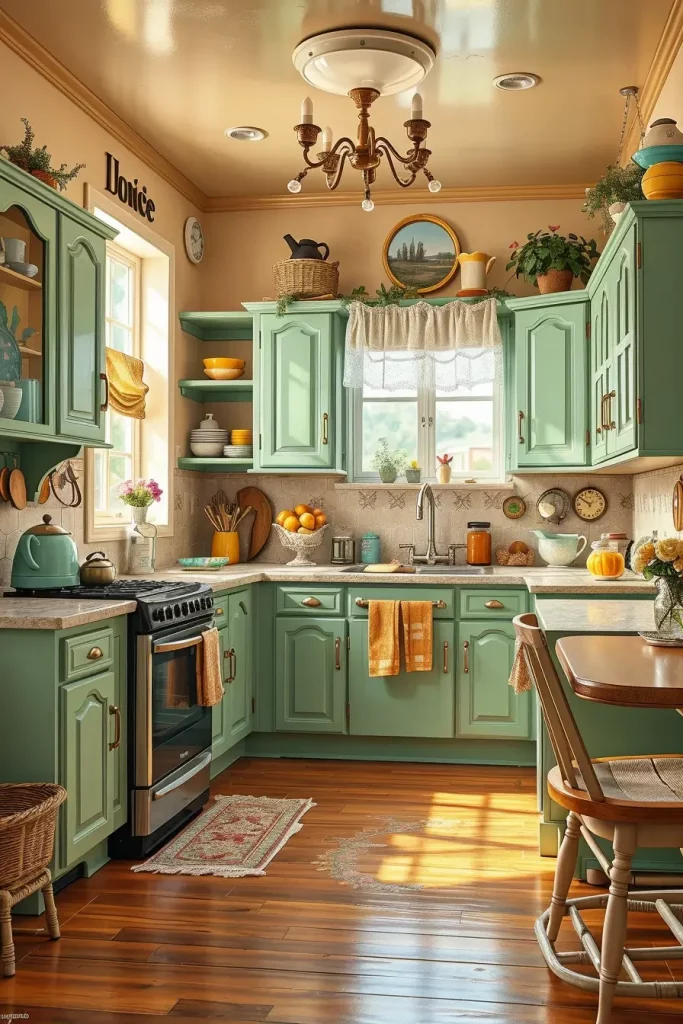
From my experience, color is one of the easiest ways to make a vintage kitchen feel authentic. According to House Beautiful, color evokes emotion in a space, and I couldn’t agree more. It’s often the first thing people see when they enter the door.
Here, I’d add a note on balance: strong colors should be tempered with neutrals, while paler palettes can be layered with wood tones to keep the space grounded.
Retro Tiles And Classic Backsplashes
Retro tiles and backsplashes are another signature of vintage kitchen design. I find that patterned tiles automatically evoke a sense of nostalgia, reminding us of the classic mid-century and farmhouse kitchens. They also are useful surfaces that shield walls against splashes.
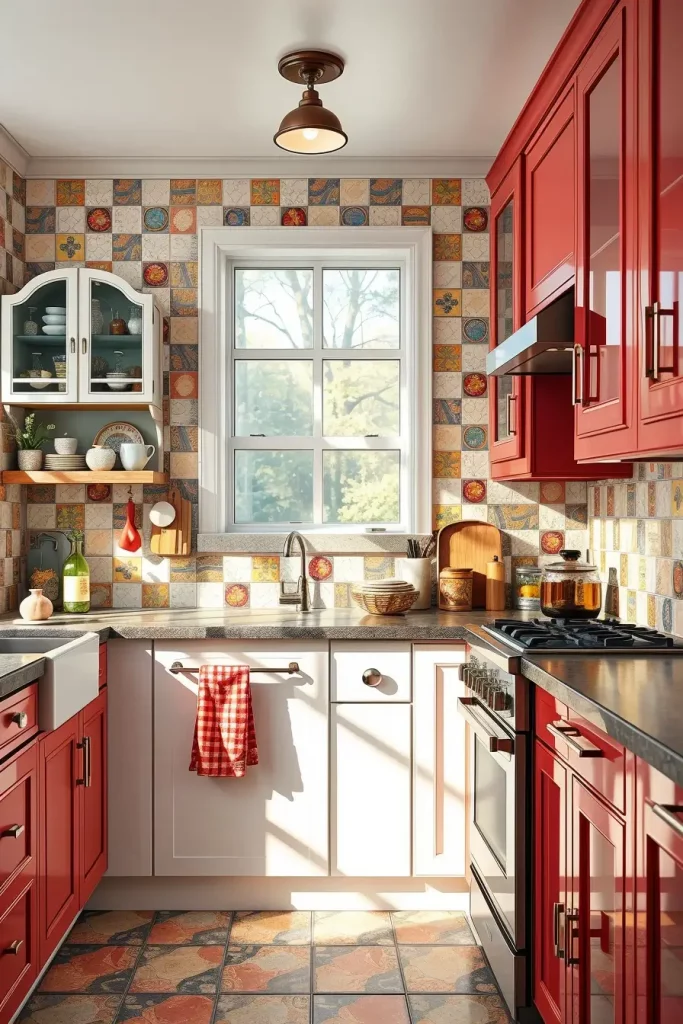
When it comes to tile selection, I favor a harmonious blend: subway tiles for a classic charm, checkerboard tiles for a retro feel, or colorful mosaics for a playful personality. These, when combined with reclaimed cabinets or vintage hardware, create a cohesive and stunning design.
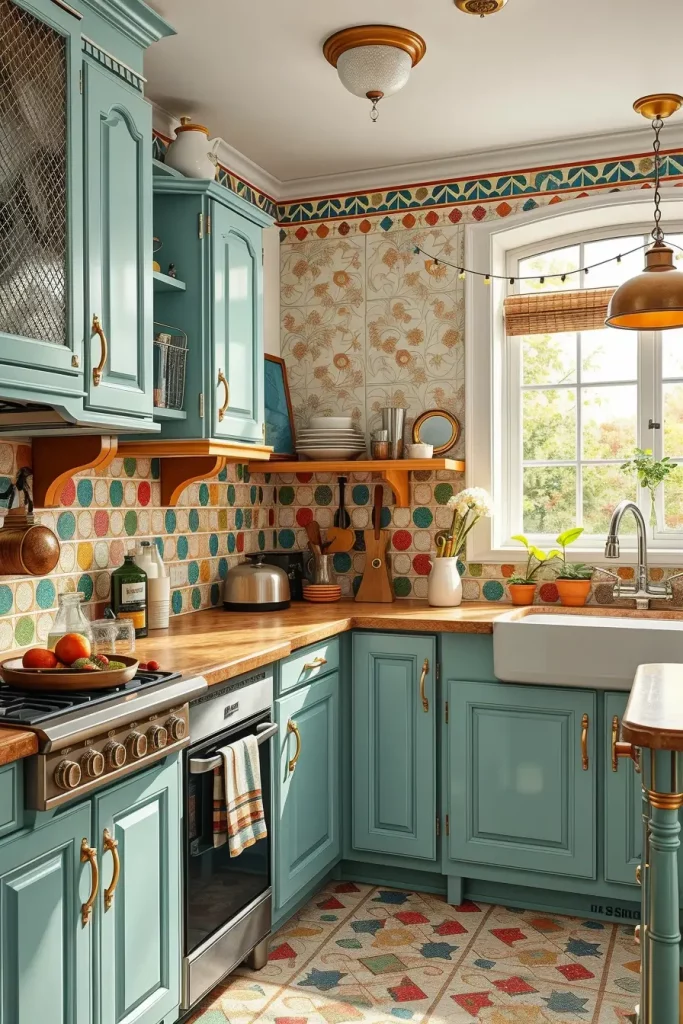
In my experience, backsplashes can make even the most basic kitchen into a stylish one. Elle Decor frequently mentions that backsplash design is a statement piece, and I think vintage tiles do that job perfectly in a thrifty kitchen.
What I would add here is the importance of the choice of grout. Grout can be colored to add to the vintage effect, or neutral grout can soften patterns. Both options can be adapted to the design vision.
The Return Of Checkered Kitchen Floors
Checkered floors are back and I think they are one of the bolder statements you can make in a vintage inspired kitchen. Black and white tiles are classic, but I’ve also seen soft gray and white or colorful checkerboard patterns that give a new twist. These floors are both long-lasting and aesthetically pleasing.
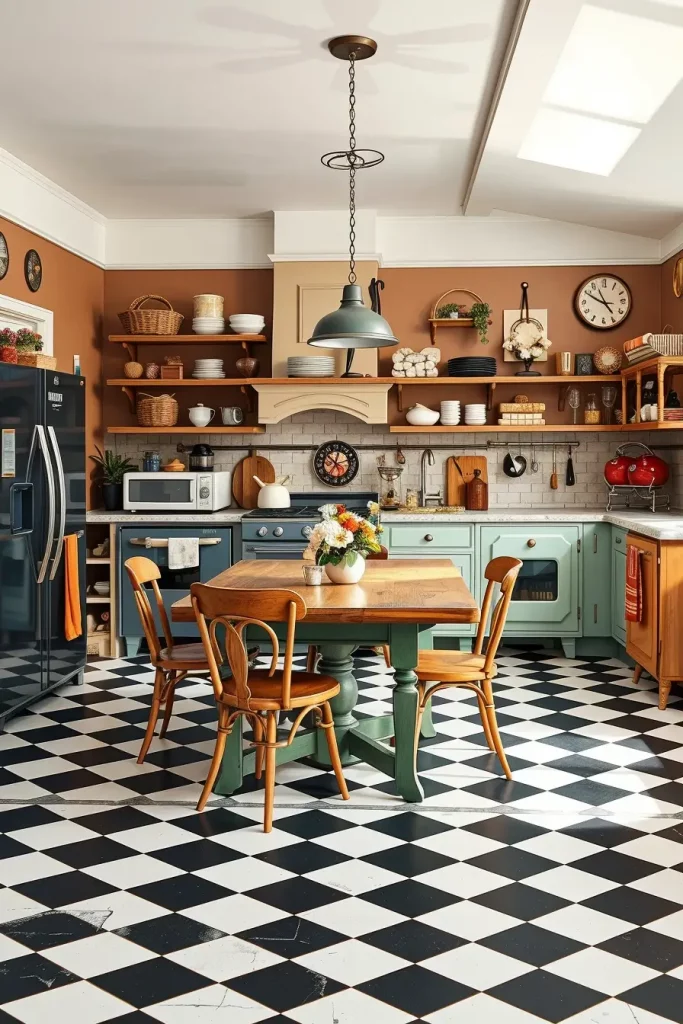
Vinyl tiles or painted wood floors are a cheap alternative. Checkered patterns anchor the kitchen and accentuate other vintage features such as farmhouse tables or vintage appliances. Their geometric pattern lends order to the overall design.
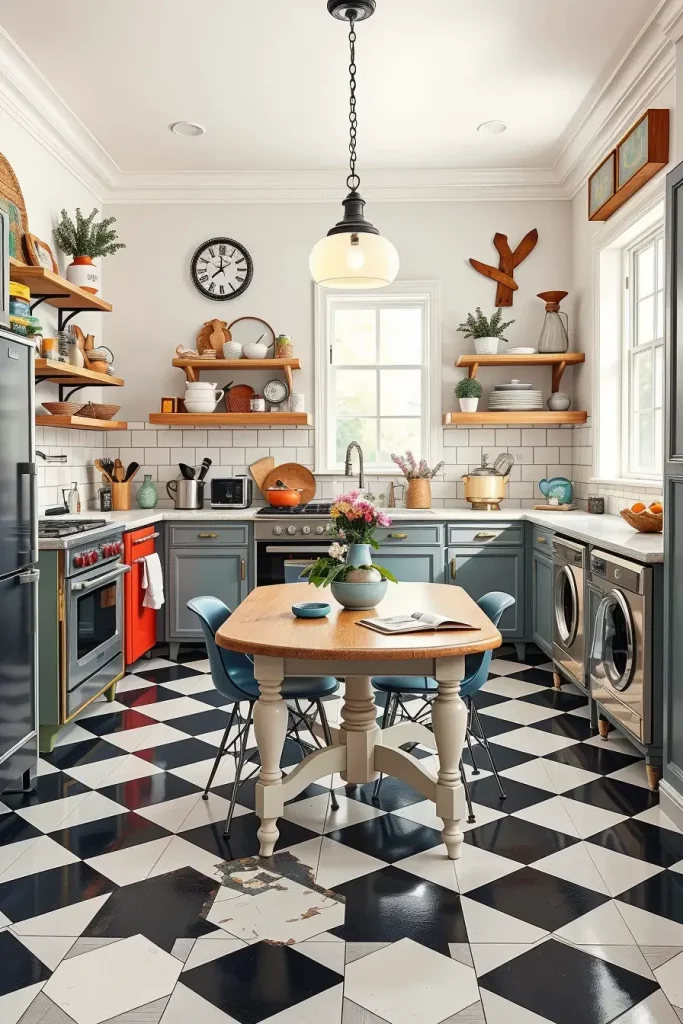
From my own point of view, checkered floors make the kitchen playful yet elegant. Good Housekeeping notes that they are timeless because they never really go out of style. I’ve seen this happen in homes from small apartments to big family kitchens.
The only thing I would add here is the importance of scale. Larger squares are bold and dramatic, and smaller checks are softer and more intricate. The selection of the appropriate scale depends on the size of the kitchen.
Cast Iron Cookware With Generational Story
There’s something classic about cast iron cookware on a stovetop or on open shelving. In my experience, it immediately gives a kitchen a sense of tradition and permanence. Cast iron not only offers unparalleled cooking performance but also carries the tales of generations passed. A well-seasoned skillet or Dutch oven carries with it the signs of use that speak of family meals and gatherings that have occurred over decades.
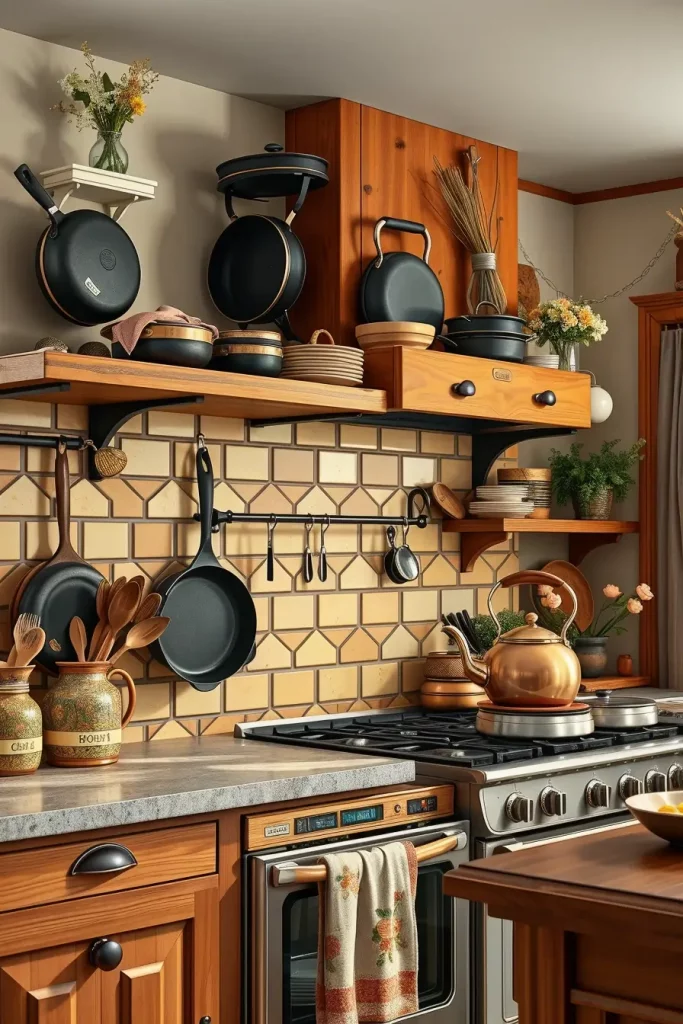
When I design a kitchen that includes cast iron, I take care to make sure that these pieces are visible rather than tucked away. A cast iron pan that hangs on a rack on the wall or is stacked on an old wood shelf is both a practical tool and an ornamental piece. Whether it’s reclaimed wood counters, tile backsplashes, or other repurposed treasures, cast iron is the perfect addition to bring warmth to the kitchen.
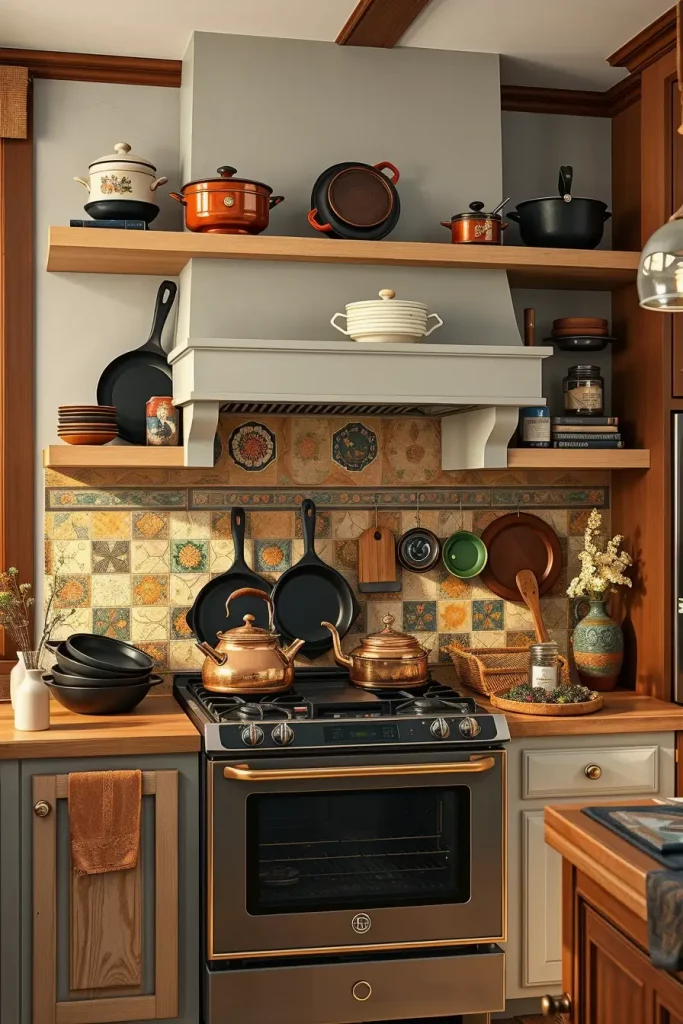
I frequently remind clients of something designers have been saying in House Beautiful: everyday objects with a history should be celebrated, not hidden. In my opinion, cast iron represents strength and authenticity, and it’s one of the most precious vintage elements you can add to a modern kitchen. What’s missing here? A good way to display your most-used piece – maybe on a stove with a copper kettle next to it – so it seems like part of the everyday rather than just decoration.
Copper Pots and Pans as a Kitchen Decor
I’ve always been drawn to the natural beauty of copper pots and pans, which add a touch of luxury while remaining approachable in a kitchen. Unlike today’s non-stick pans, the copper develops a beautiful patina that makes each piece unique. Copper cookware hung above an island or stove is an instant reminder of old world charm, while keeping essentials within reach.
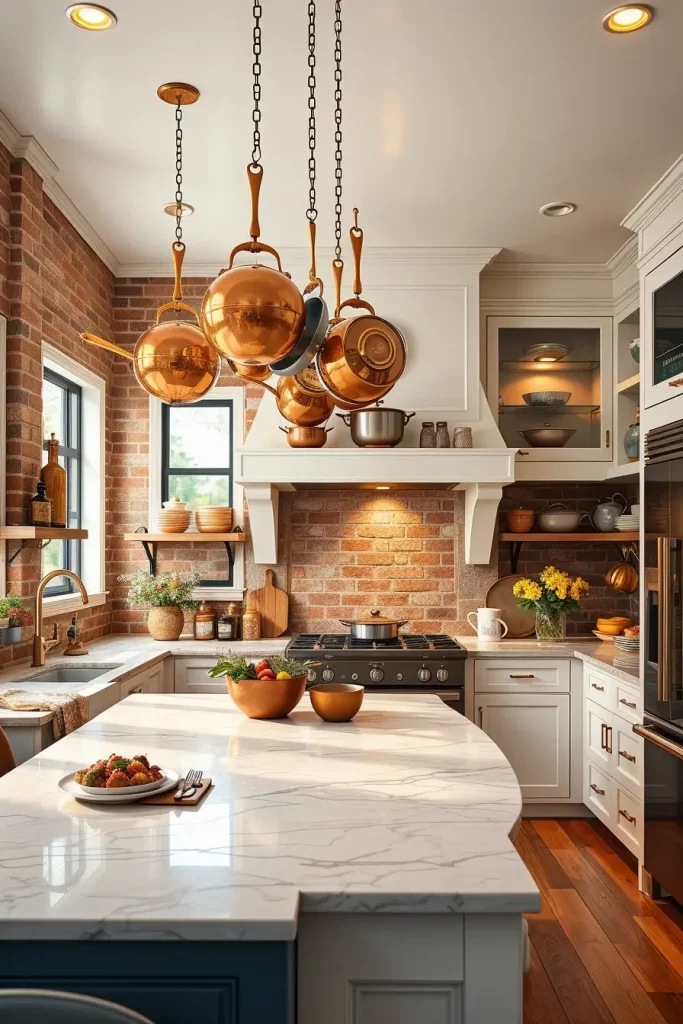
The functionality of copper cookware is indisputable, but its most important contribution to interior design is its decorative value. I prefer to use them in combination with open shelving, exposed brick walls or marble countertops to achieve a sophisticated blend of vintage charm and modern utility. Their mirror-like surface naturally lights the room and adds visual interest without dominating the space.
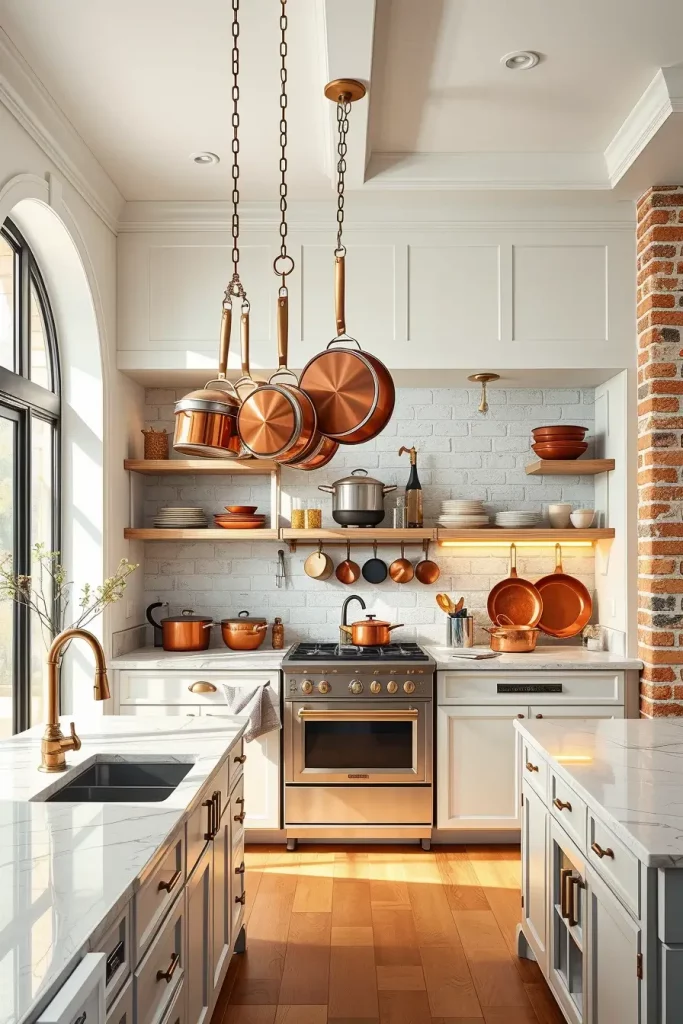
Personally, I think of copper as a link between functionality and beauty. Architectural Digest has featured many designers who have noted how the addition of a single or two really special copper pieces can change the overall mood of a kitchen. To finish this look I would add a subtle light above the cookware to highlight its natural shine and draw the eye upwards.
Vintage Textiles For A Warm Kitchen Look
Textiles are one of the most overlooked ways to add vintage style to a kitchen. From patterned curtains to embroidered tea towels, textiles can soften the harder surfaces of tile, metal and wood. I find a colorful table runner or antique linen napkins can instantly make a space feel cozy and lived in.
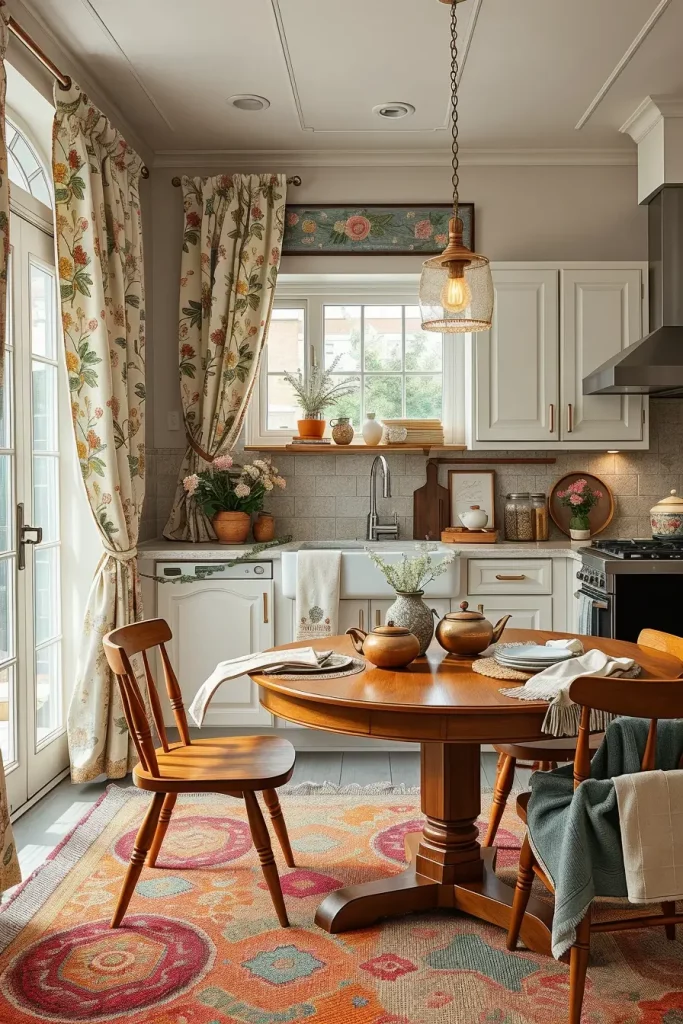
When selecting textiles, I look for ones that have texture and history–a handwoven rug picked up at a flea market, or a set of embroidered tablecloths handed down from family. These pieces bring depth to the kitchen, weaving narratives and warmth that mass-produced fabrics can’t touch. Overall, the design is not only welcoming but also stylish, with vintage treasures effortlessly merging with modern elements such as sleek cabinetry.
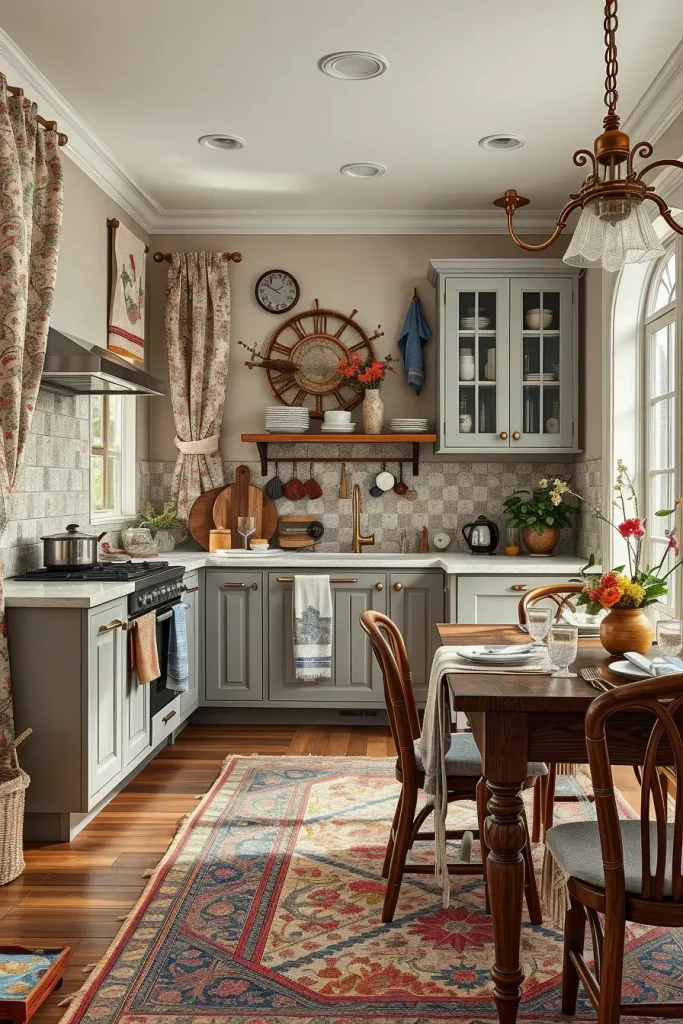
From my own point of view, the kitchen is more personal when there are these little details. Experts from Better Homes & Gardens stress the importance of incorporating fabrics for both style and functionality, highlighting how they strike a balance between aesthetics and functionality. To further this appearance, I would recommend that you use seasonal textiles, for example, lighter fabrics in summer and heavier woven ones in winter, to keep the kitchen flexible and welcoming.
Old-Fashioned Pantry Jars And Storage Ideas
Although today’s kitchens are full of clear jars and canisters, old-fashioned pantry jars have a completely different look. I love to use old glass jars with embossed letters or metal clasps to store dry goods such as flour, sugar or pasta. They are functional storage and decorative on open shelves or in an open pantry.

The trick is to combine utility and beauty. For instance, you can use recycled apothecary jars or ceramic crocks to make storage a work of art. In my designs I tend to mix thrifted containers of different sizes to create a collected appearance. The combination of glass, ceramic and even old tin containers makes everyday ingredients seem special and worthy of displaying.
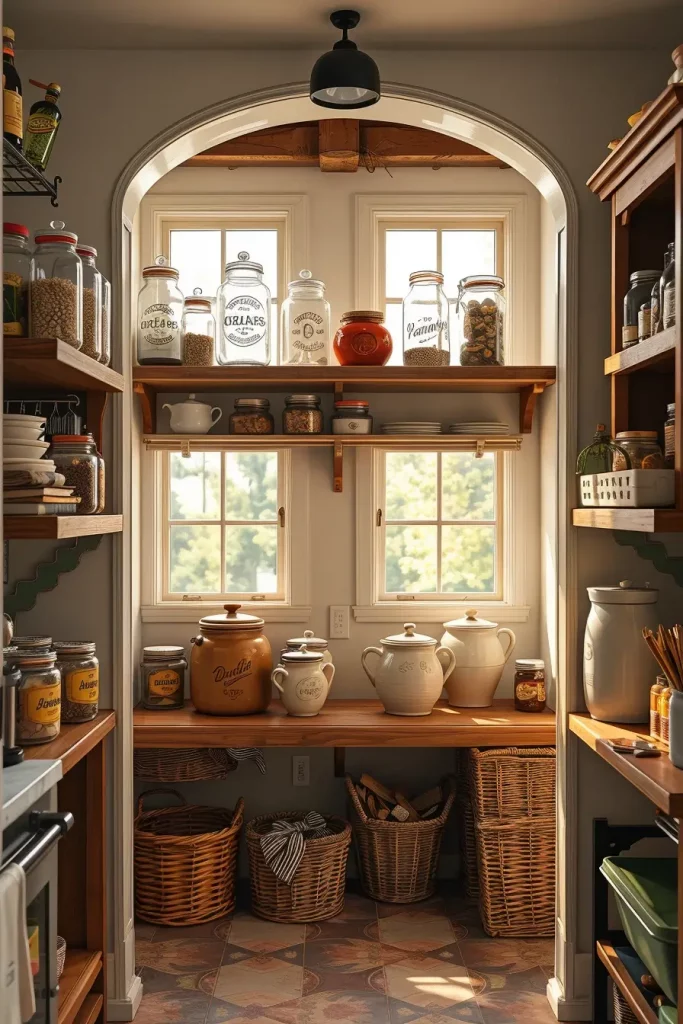
Personally I’ve found that adopting this style makes cooking more fun. Martha Stewart has long been a proponent of smart kitchen storage, and vintage jars are nothing if not that: clever organization with style. What’s missing here is perhaps a dedicated pantry nook styled with baskets, wooden shelves and jars in uniform rows to showcase both form and function.
Wall Art And Signage From Thrift Shops
From furniture to cookware, wall art and vintage signage contribute to the kitchen’s personality and narrative. I find myself looking for old recipe posters, enamel signs or framed botanical prints at the thrift shop to liven up empty walls. These items are more than mere space fillers; they’re a story of food, family, and tradition.
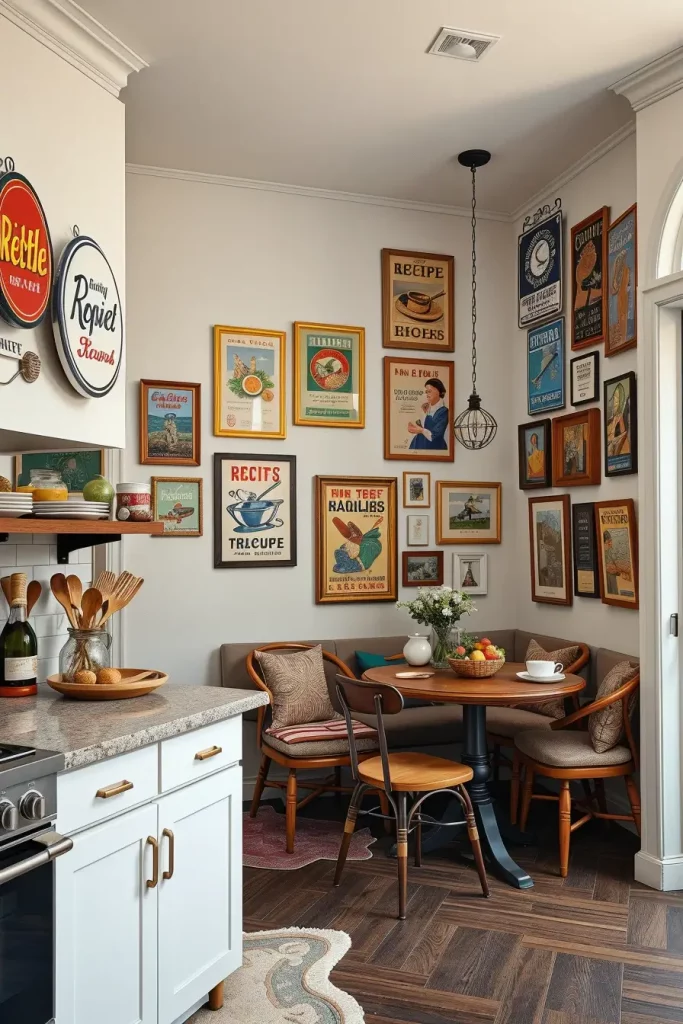
When I bring this concept into play, I am thinking about balance. A wall of framed vintage advertisements will look great above a dining nook, and a single large sign may be ideal above the stove. I’ve also discovered that smaller thrifted treasures such as chalkboards or framed menus can add both utility and decor to the kitchen.

From my point of view, these design details hark back to kitchens I grew up in, where the walls were never blank, but always had a story to tell. Art is a great way to make functional spaces your own, and according to designers from Elle Decor, I couldn’t agree more. To take this look even further, I’d recommend incorporating modern frames into vintage pieces – it not only protects the artwork but also ensures they seamlessly blend into a contemporary kitchen.
Vintage Kitchen Gadgets That Are Still Functional
One of the pleasures of thrifting is coming across collectible kitchenware that is perfectly usable today. Cast aluminum molds, wooden rolling pins and hand-crank egg beaters all provide functionality and a hint of vintage to the kitchen. In my experience, these things look great when they’re out in the open instead of tucked in drawers.
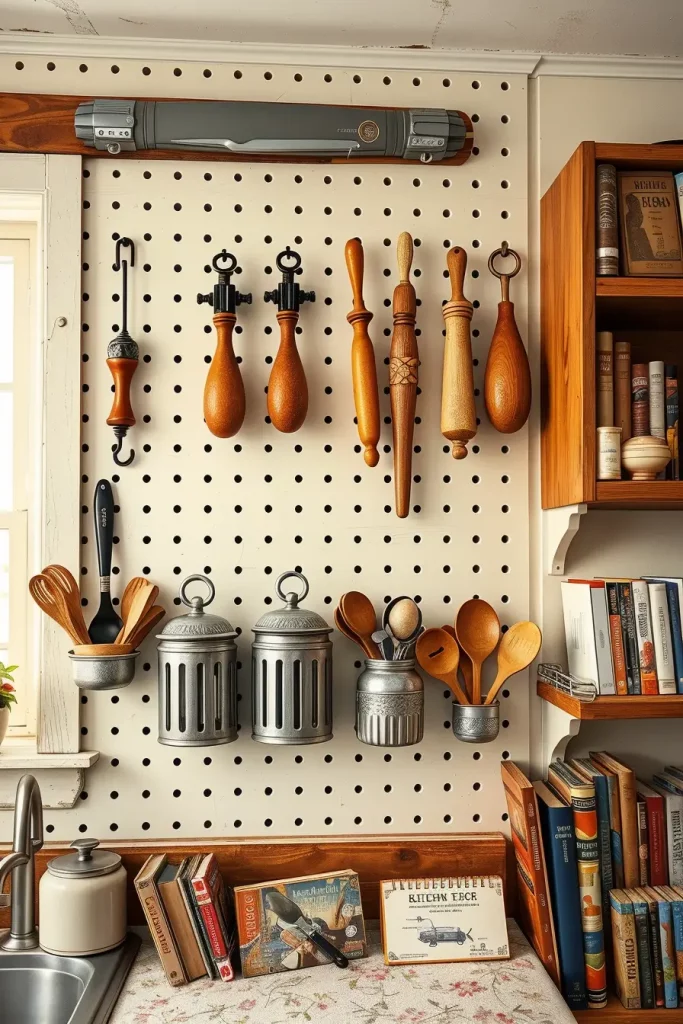
I love to use these collectibles to decorate kitchens, by filling crock jars with them, hanging them on pegboards or on shelves next to cookbooks. This creates a curated, yet welcoming environment. In addition to their cool factor, many vintage tools were built with better craftsmanship than today’s disposable products, making them worth using every day.
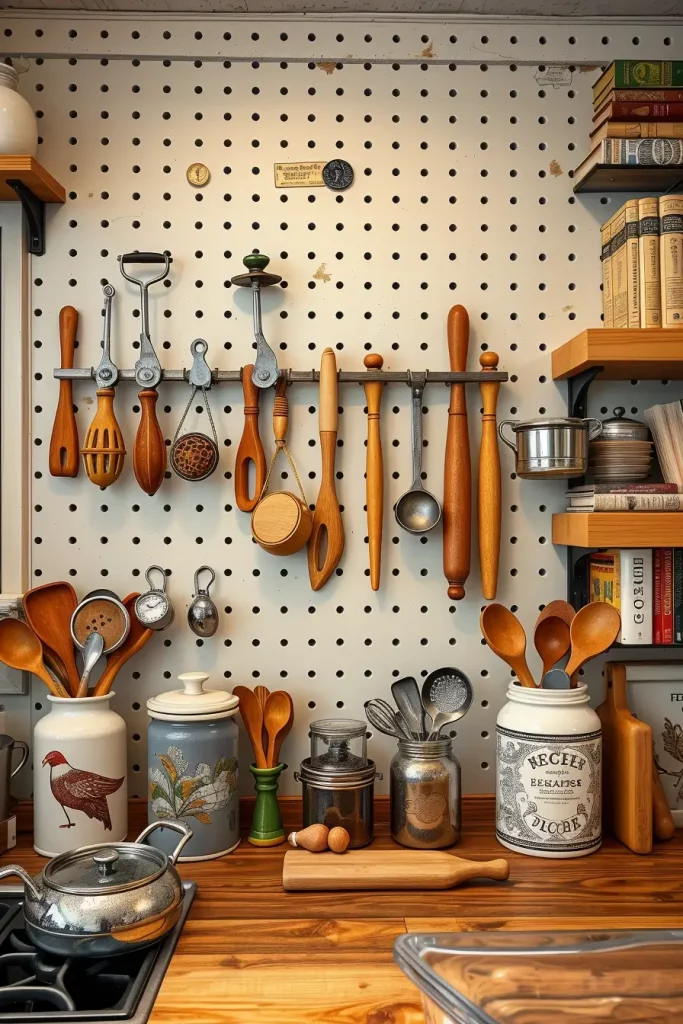
Personally, I feel these tools add a feeling of joy and nostalgia to the cooking experience. Many Country Living designers note that vintage tools can break up the sterile or modern feeling of a kitchen. I would also incorporate some sort of metal (such as brass hooks or iron holders) that would go well with the old look of the tools, but keep them easily accessible.
The Beauty of Worn Wood and Patina
In my opinion, there is nothing that warms up a kitchen more than worn wood with a natural patina. Whether it’s a reclaimed butcher block countertop, a farmhouse table, or shelves made from reclaimed boards, wood with a history adds depth and authenticity to the room. Unlike new finishes, the flaws in aged wood give it a story to tell.
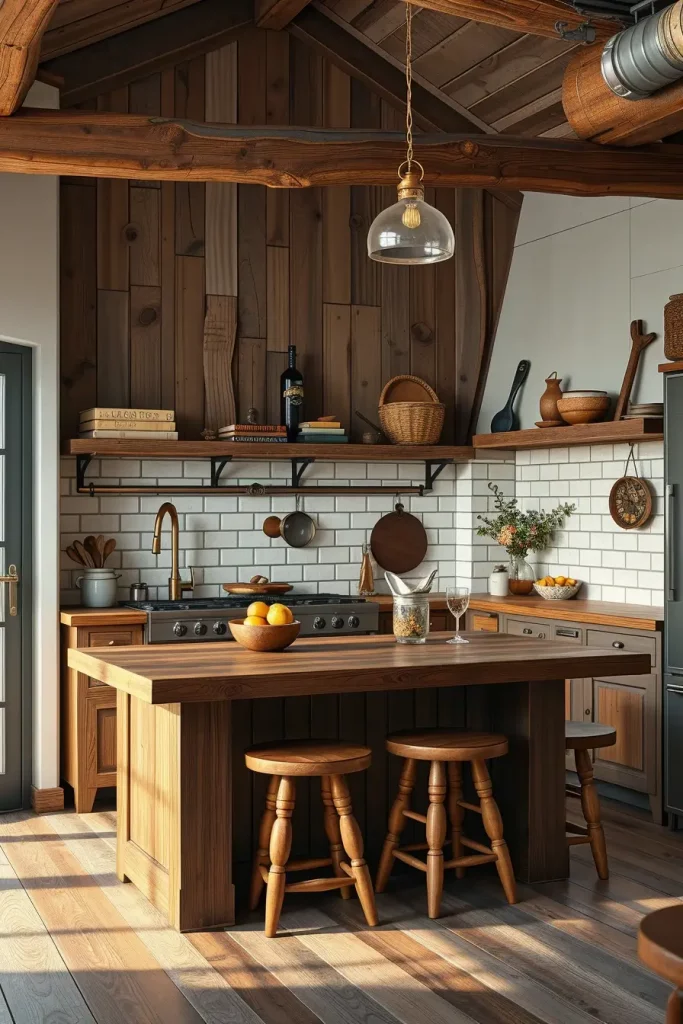
I often create contrast between weathered wood and polished stone or tile, which gives a balanced appearance that seems layered and timeless. Antique hutches, vintage stools, or farmhouse benches contribute a touch of character without overpowering the modern kitchen’s functionality.
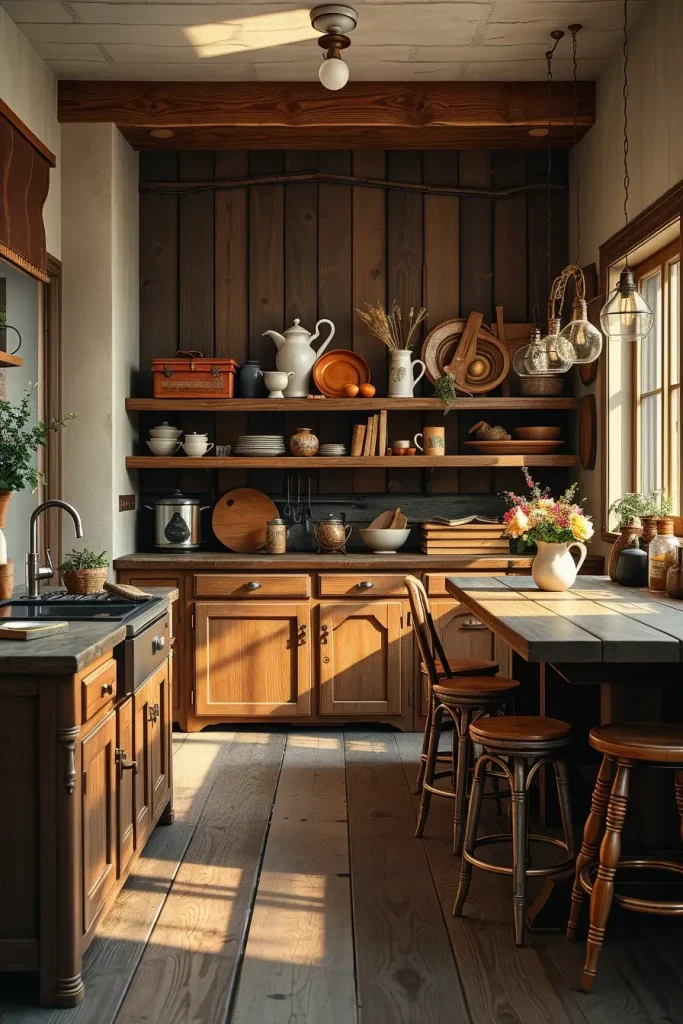
To me, the kitchen is one of the best places to allow the imperfections of wood to shine. Designers frequently observe in Dwell magazine that aged surfaces make an environment more approachable, comfortable. What would round out this idea? Subtle lighting – warm under-cabinet LEDs to highlight the natural grain and texture of the wood, keeping it the center of attention.
Fashioning a Fusion of Thrift Store Finds and Contemporary Touches
One of my favorite kitchen design techniques is mixing thrifty finds with sleek, modern accents. This gives a curated look that is both unique and intentional. For example, an old dining table with modern pendant lights, or mid-century chairs with glossy cabinets, create a balance between old and new. It’s a way of celebrating history without losing modern convenience.
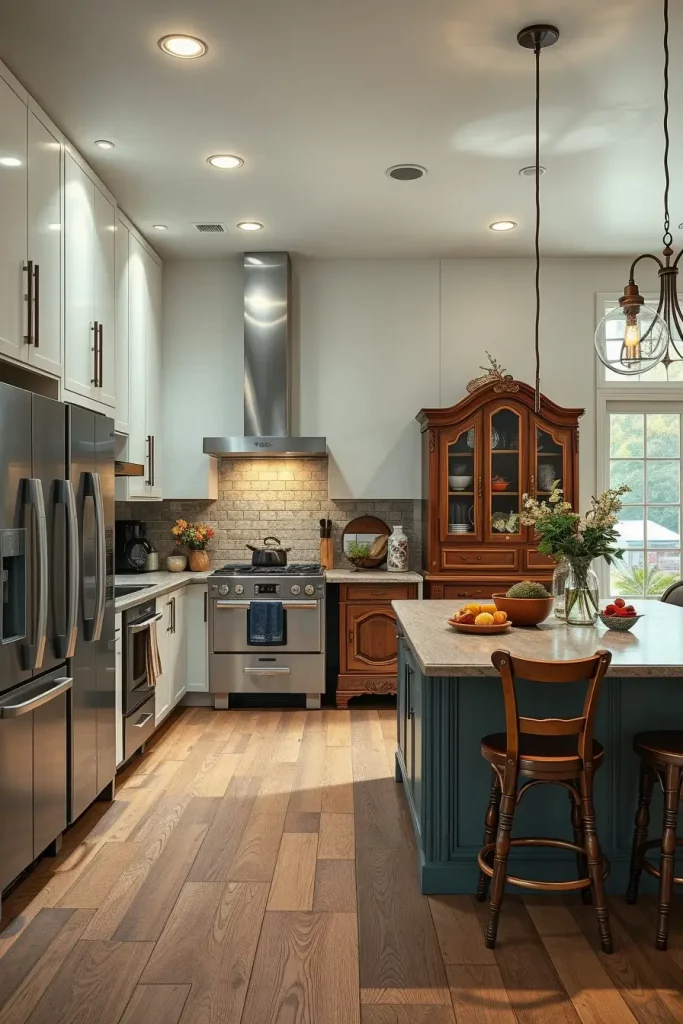
When I create these kinds of spaces, I tend to use thrifted statement pieces as the base, and then add modern touches for functionality. A secondhand wooden hutch in a neutral color works well with stainless steel appliances, and vintage stools create warmth in a modern kitchen island. This approach makes the kitchen feel warm and not too uniform.
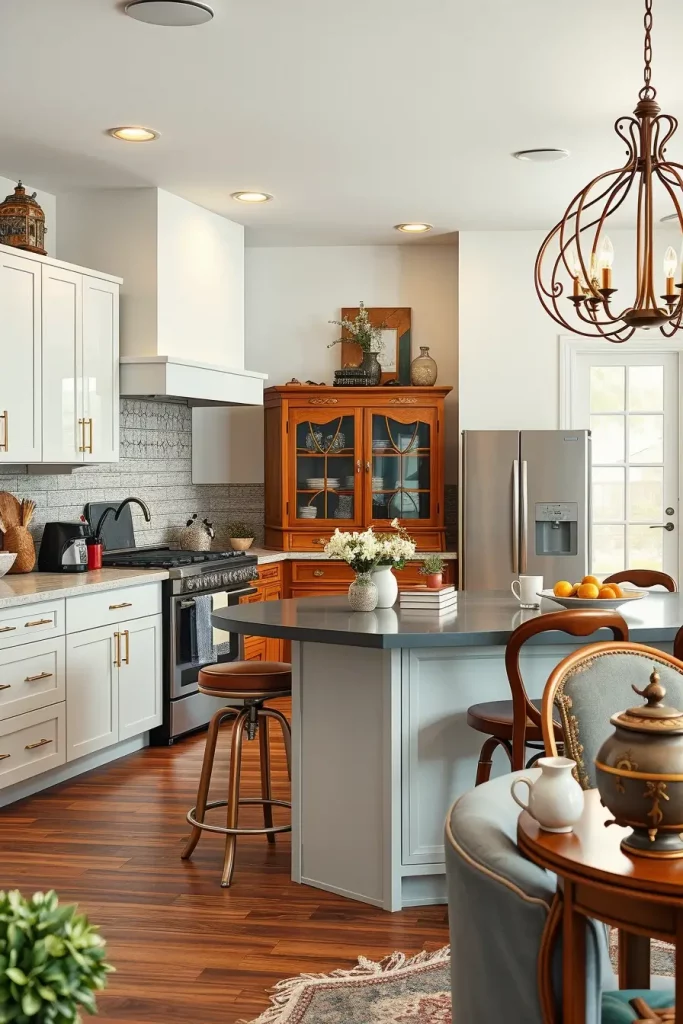
In my own projects, I’ve found that this combination is what makes a kitchen memorable. Domino Magazine often suggests to clients that they should think of one vintage element that they really love and let it stand out, instead of cluttering the room. I would round out this idea with a few modern accents, such as streamlined barware or minimalist shelving that add a touch of functionality without letting the vintage finds take center stage.
Seasonal Vintage Details For Kitchen Designs
Kitchens don’t have to be static – seasonal vintage accents keep the space fresh and adaptable. I enjoy changing my decor to match the seasons, with things like enamel pitchers full of summer flowers, ceramic pumpkins for fall, or frilly holiday linens in winter. These items are simple to thrift and give the kitchen a fresh feel all year round.
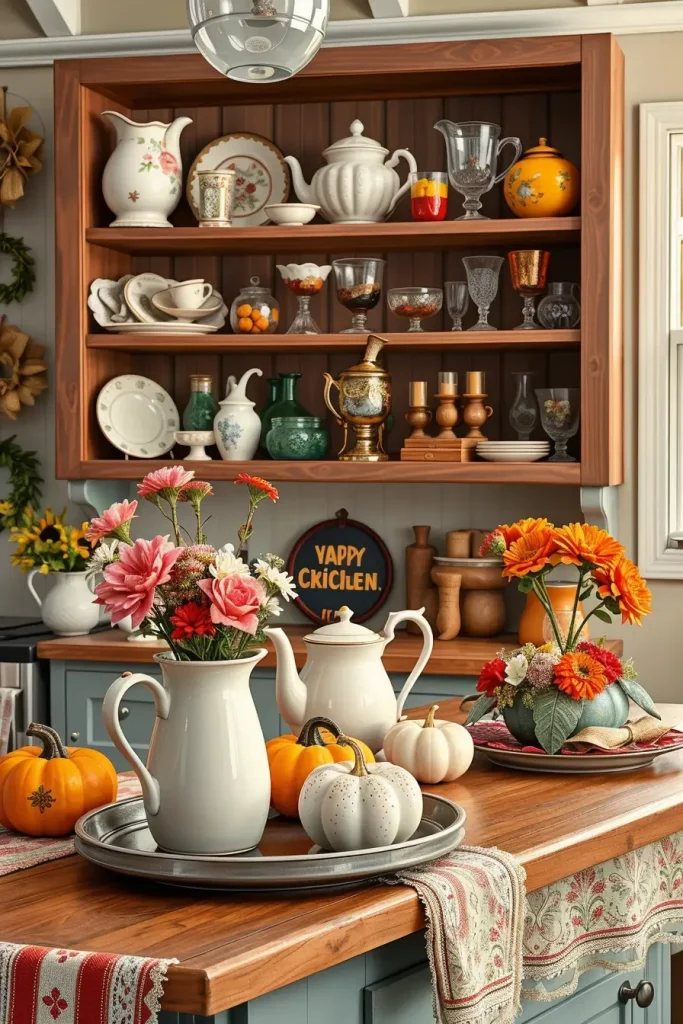
Some of my favorite pieces to use are old cookie tins at Christmas, colorful glassware in the spring, and heavy stoneware for the cozy winter months. Each piece not only brings a delightful touch but also connects to traditions and memories. By adding these touches to an existing design, the kitchen feels more personal without the need for a major renovation.
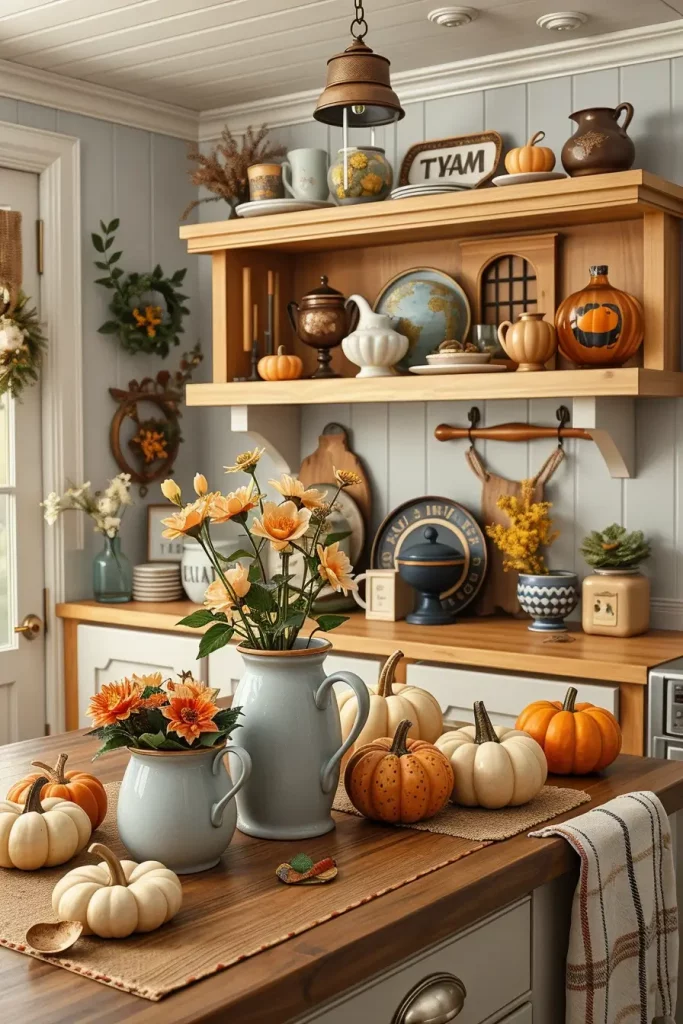
Personally, I’ve always loved how little seasonal changes can radically change the mood of a kitchen. Experts at Better Homes & Gardens suggest keeping a small box of changing decor items so that your vintage finds will remain in good condition and be flexible. To take this concept further, I would recommend having one open shelving or display space that evolves with the season – allowing your kitchen to have a constantly changing personality.
How To Thrift Smart for Kitchen Trends
While thrifting for kitchen decor is rewarding, smart thrifting makes all the difference. Whether it’s a vintage piece of furniture, functional kitchenware, or something unique to decorate a wall, I always start with a clear list of what I need. This stops impulse buys and ensures the pieces I bring home will improve the design.
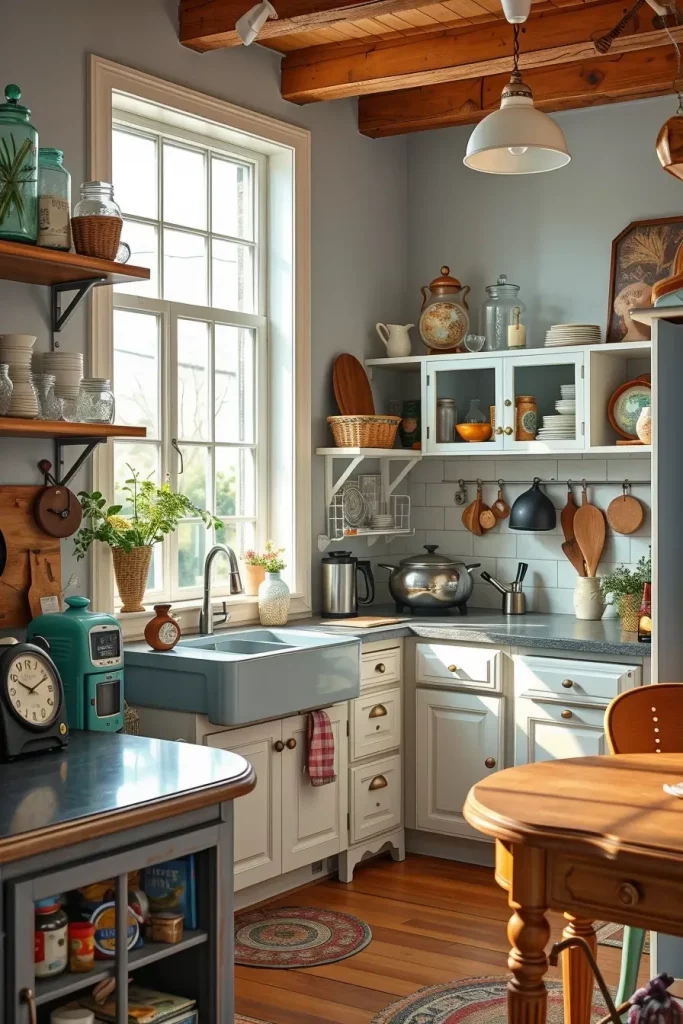
In my experience, it’s all about quality and condition. For example, I seek out solid wood furniture instead of laminate, glass jars with intact seals and textiles that are not heavily damaged. I also suggest checking out thrift shops on a regular basis because stock changes fast. Shopping estate sales and flea markets can also reveal hidden treasures that are great for kitchens.
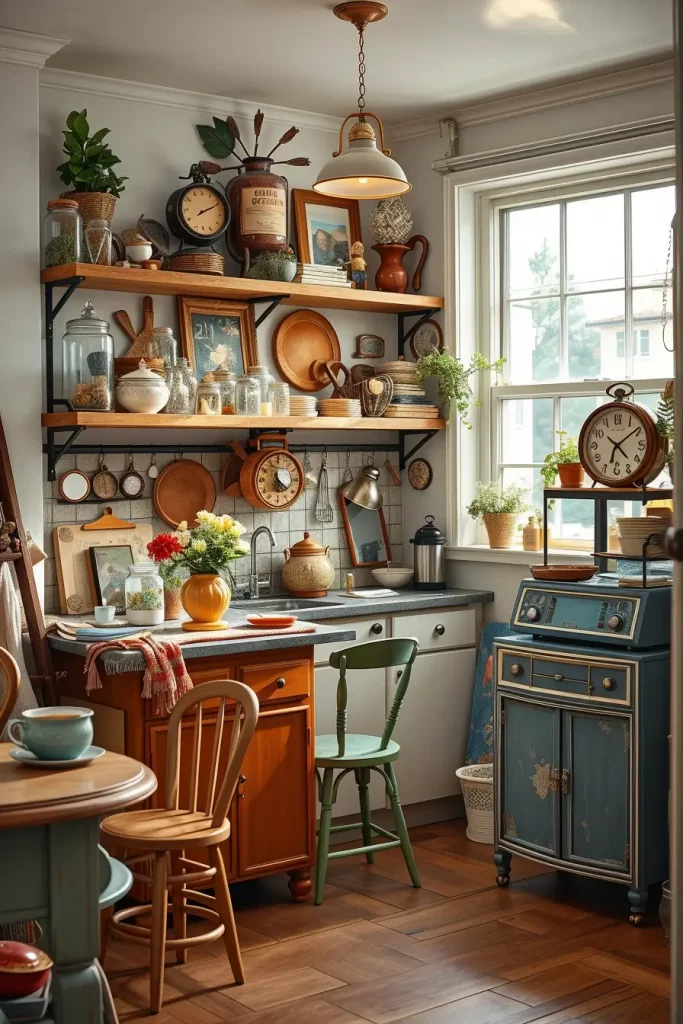
From my point of view, patience is the most important. Apartment Therapy points out that the best thrifty interiors are created by buying over time rather than trying to source everything at once. How could this idea be even stronger? I’d recommend combining thrifting with online marketplaces – this will give you a wider reach, while still enabling you to prioritize secondhand and sustainable design.
Sustainable Fashion: The Impact of Secondhand Shopping
One of the main reasons I love using thrifted and vintage kitchenware is because it’s sustainable. By opting for secondhand, you’re contributing to a more circular economy and reducing waste. Every time I use a thrifted piece, I know I’m making it last longer and at the same time avoiding the environmental costs of new manufacturing.
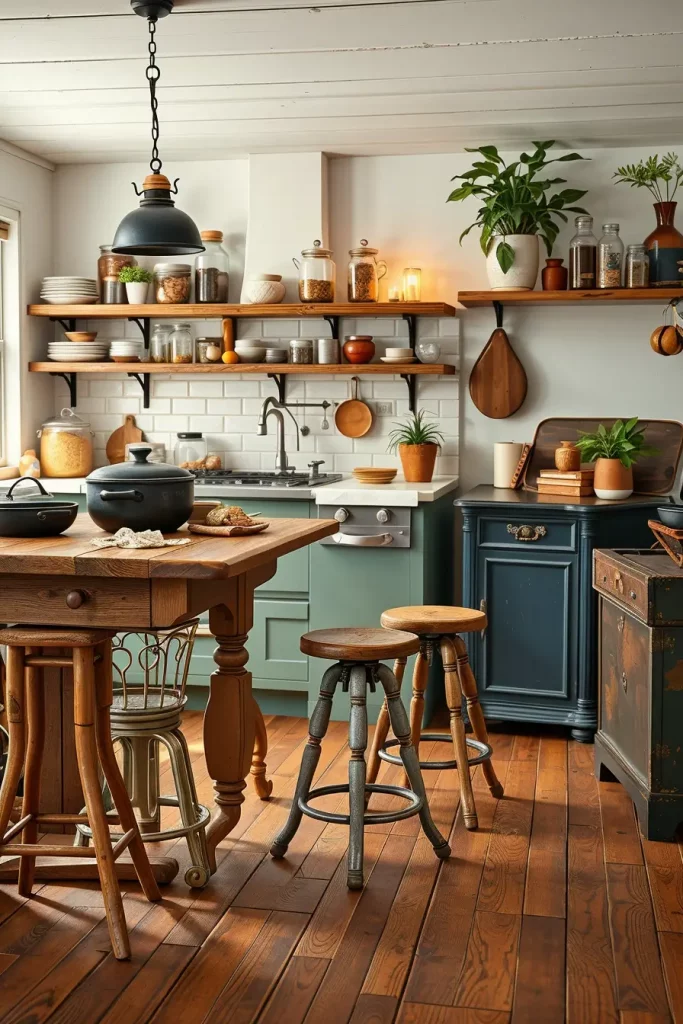
In practice, I favor solid secondhand objects such as wooden tables, cast iron skillets, or glass storage jars. These pieces are usually constructed to be long-lasting and can be easily incorporated into modern designs. For example, an old stool can be turned into a kitchen island, and an old cutting board can be made into an ornamental serving tray.
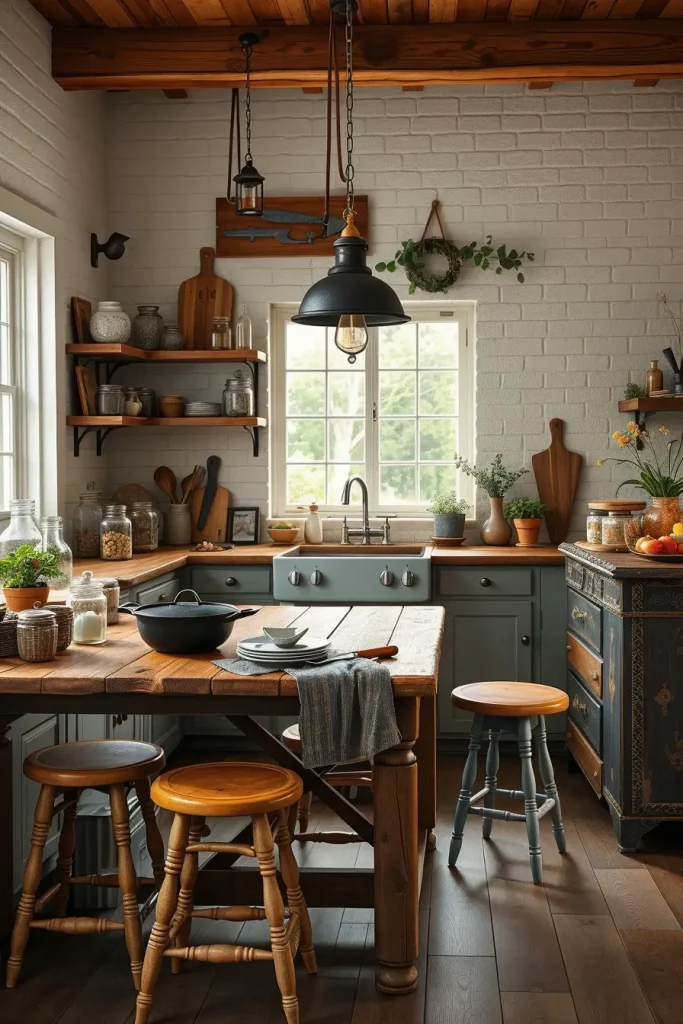
Personally, I think designing sustainably makes the space more meaningful. The New York Times recently highlighted how secondhand decor is becoming an important part of eco-conscious living. To take this concept further, I’d suggest that you should aim to go for multifunctional vintage items that reduce the need for extra purchases – for example, an antique chest that doubles as a storage and display unit.
Retro Seating: Stools, Chairs, And Benches
One of the most effective ways to add retro seating is with stools, chairs, and benches. I’ve found that seating instantly transforms the appearance and atmosphere of a kitchen. A collection of chrome-legged diner stools adds a playful retro touch, and a reclaimed wooden bench adds rustic warmth.
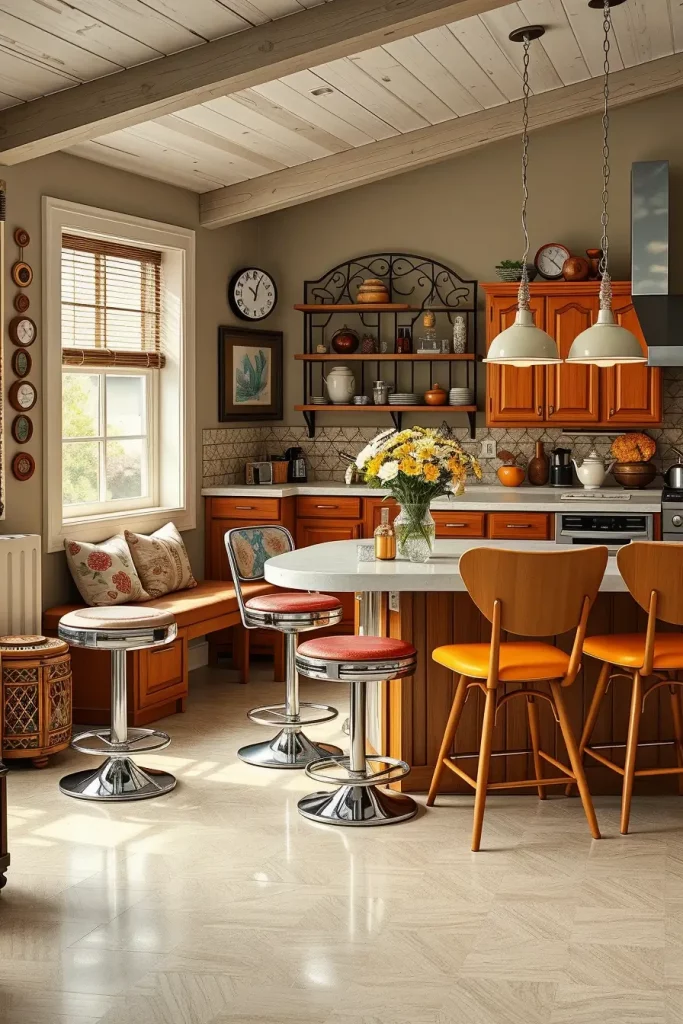
When choosing seating, I look for a combination of durability and style. Mid-century chairs or those with curved backs can be reupholstered and refinished to fit modern kitchens. Benches are a great choice for dining nooks, offering versatile seating for both daily meals and gatherings.
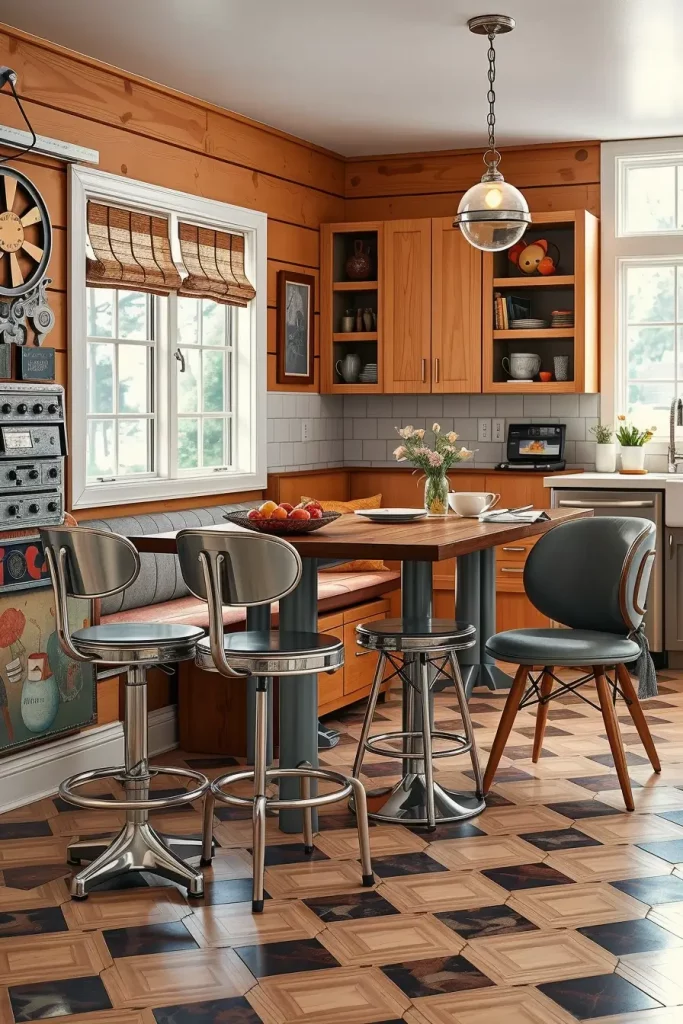
From my point of view, seating is one of the most personal design features in a kitchen because it’s where people come together. Country Living often features the way that thrifted seating pieces have a story to tell while still being used for practical purposes. In order to complete this design, I would combine retro seating with a modern dining table or island – the perfect balance between nostalgia and functionality.
Adding Vintage Rugs to Kitchen Spaces
Color and texture: Vintage rugs introduce a touch of unexpected charm and comfort to kitchens, softening hard surfaces and adding color. I especially like to use a runner along the sink area or a small rug near the stove – it makes cooking more fun and less exhausting and adds a decorative focal point.
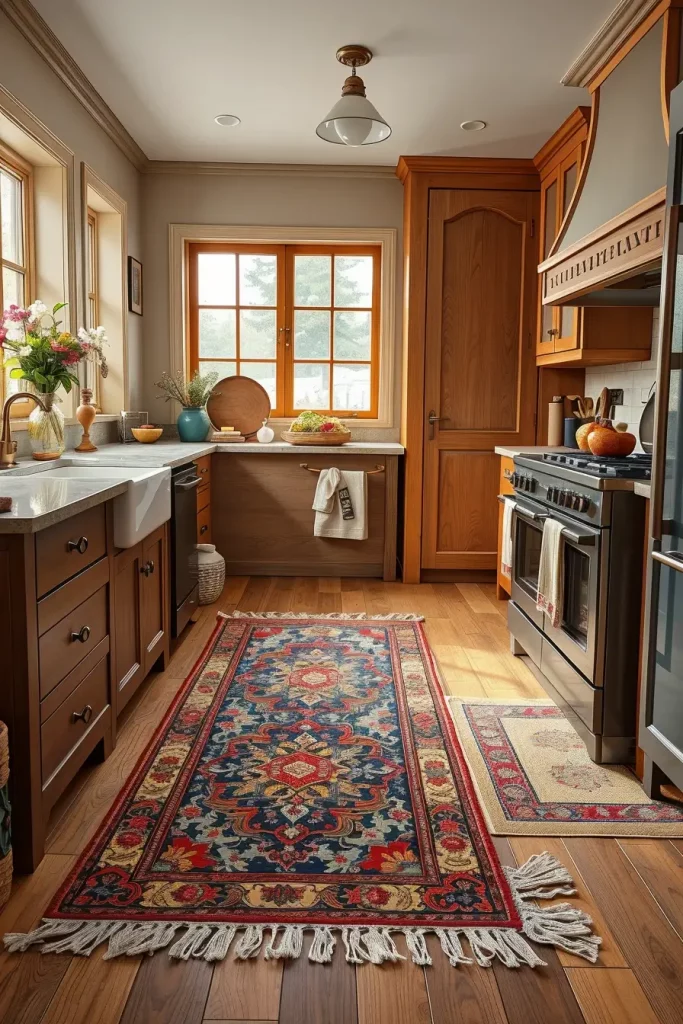
Durability is the key to selecting rugs for kitchens. I suggest natural fibers such as wool or cotton that can take heavy foot traffic. Thrifted rugs or handwoven kilims in a Persian style are often a great choice, as their complex patterns can hide small spills and stains. A rug can also be used to unify other vintage pieces into a complete look.
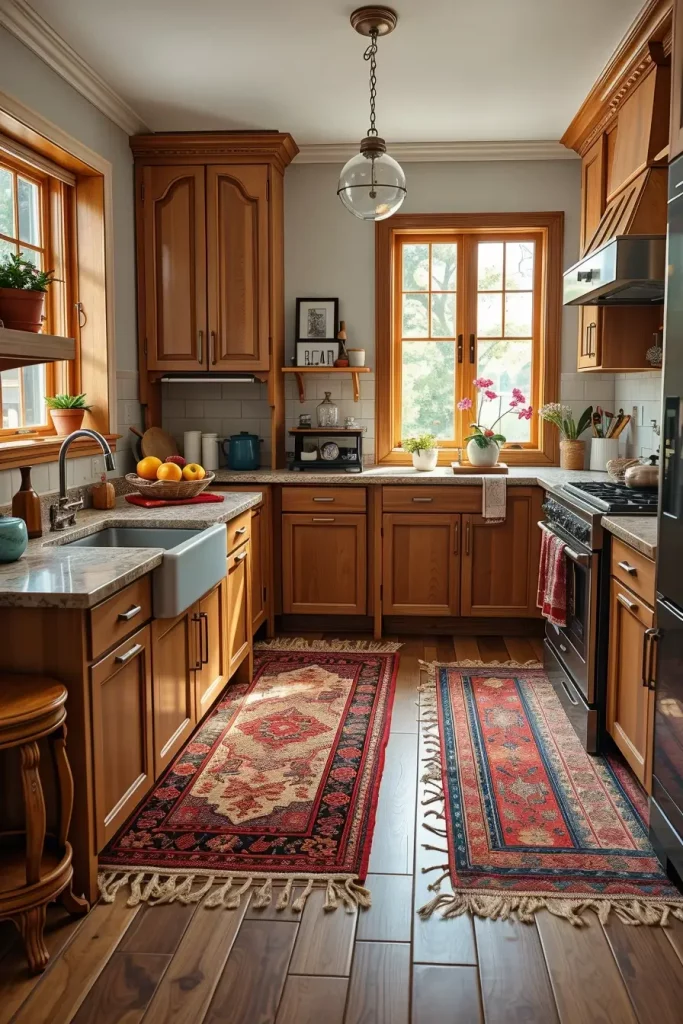
Personally, I’ve always found that rugs can take a kitchen from utilitarian to welcoming. According to HGTV, layering rugs is another way to create dimension and warmth in high-traffic spaces. To take this idea further, I would recommend placing a rug pad underneath to keep it in place and to help it last longer.
Everyday Elegance With Thrifted Silverware
While it is often a forgotten utensil, thrifted silverware adds a touch of everyday elegance to kitchens. I like to show it in glass jars on counters or in vintage trays, so it’s easy to reach and pretty to look at. Tarnished silver spoons, forks, and knives have a magic that new flatware just can’t match.
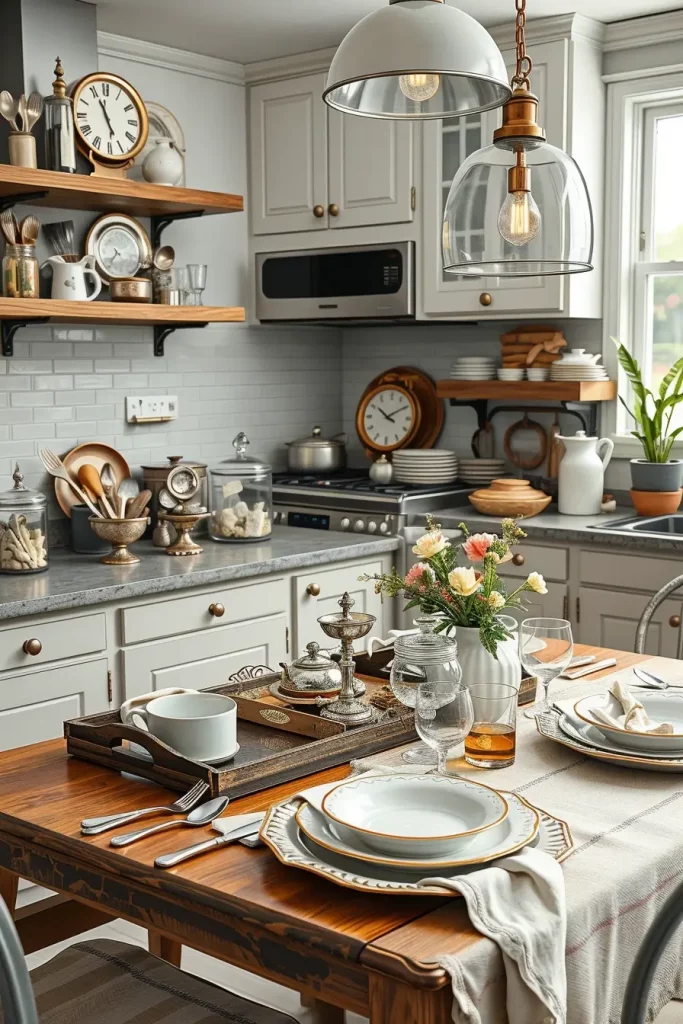
When thrifting, I look for full sets, or mixed sets that can be cleaned up for formal occasions or left with patina for casual meals. Using silverware in conjunction with other antique table settings such as linen napkins or porcelain dishes creates a classic table setting.

In my own kitchen, I’ve discovered that using thrifted silverware every day makes everyday meals feel special. Experts at Southern Living often say that silverware shouldn’t be reserved for holidays only, but can be a part of daily fun. To finish this idea, I’d recommend buying a vintage silverware chest or display case that allows these pieces to be organized while still being displayed for their beauty.
Picking Up Pyrex And Old Glass
One of the most iconic ways to add a vintage flare to a kitchen is through the collection of Pyrex and retro dish sets. These patterned and colorful pieces instantly light up a space while providing actual functional use for cooking and serving. I find that open shelving or glass-front cabinets to show off them make for a delightful focal point and set the tone for the entire room. A collection of vintage bowls or striking patterned casseroles is an instant way to ground a kitchen in nostalgia, while still feeling fresh in a contemporary setting.
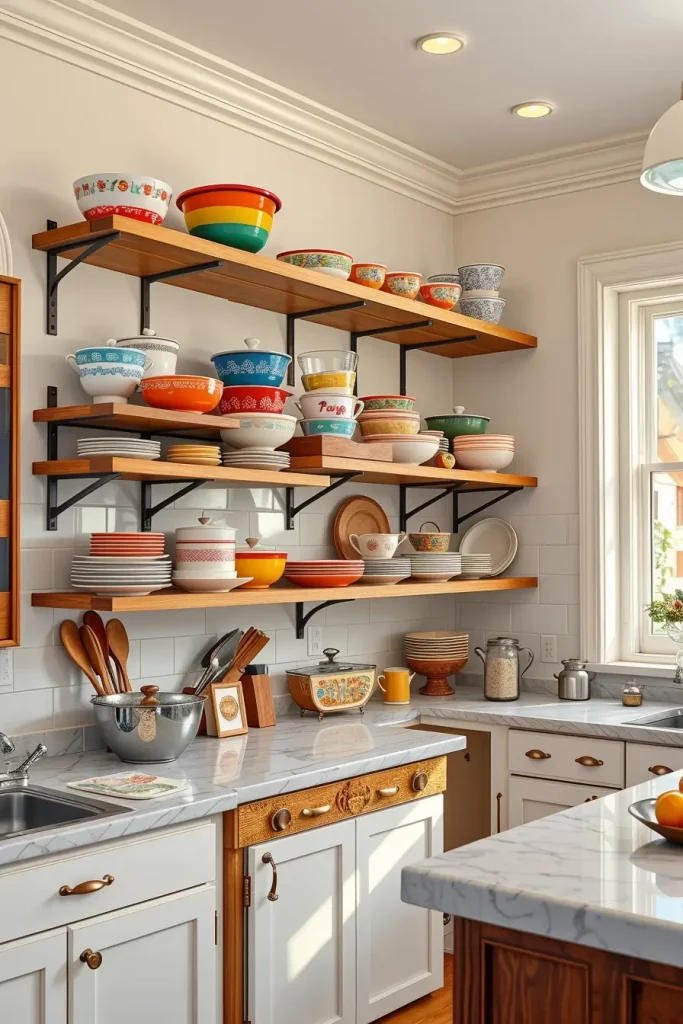
When it comes to furniture, I like to pair these dish sets with simple wooden shelves, vintage china cabinets or thrifted display cases. The great thing about these retro kitchen staples is that they work well with both neutral palettes and bold color interiors. Personally, I think they make a space warmer that would otherwise feel too stark. For example, a white modern kitchen with a splash of orange Pyrex or floral glassware suddenly seems curated and personal.
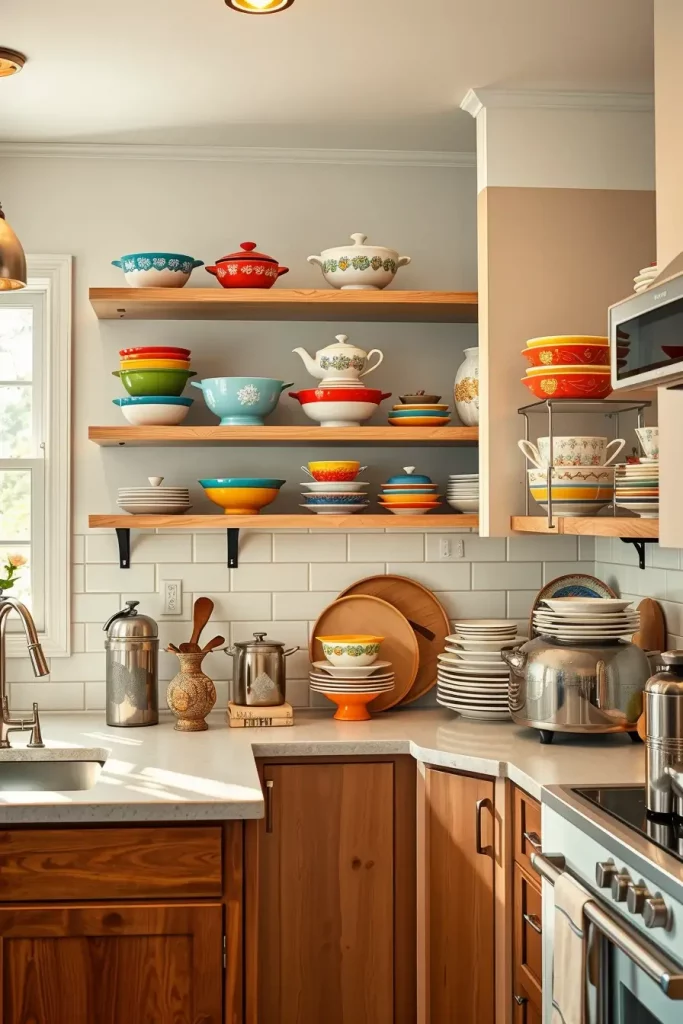
In my experience, professional designers tend to suggest that clients use decorative dishware as a layering technique. As told to House Beautiful, “Collections are a great way to take functional objects and turn them into instant decor.” I couldn’t agree more with this approach and I’ve seen it work magic in making a kitchen feel alive instead of staged.
I think this section will be improved by including guidance on mixing eras of dishware. For instance, mixing 1960s Pyrex with modern minimal dish sets will give a playful contrast, but not overwhelming. This anchors the kitchen while still allowing it to have character.
Inexpensive Ideas To Start A Vintage Kitchen Look
Creating a kitchen that looks like it’s from the past doesn’t have to be expensive. I’ve witnessed amazing transformations accomplished with affordable updates such as hardware swaps, retro-inspired lighting, or using small decor items from local thrift stores. Paint is another powerful tool – muted greens, buttery yellows or classic white can create the stage for vintage design without the need for a full remodel.
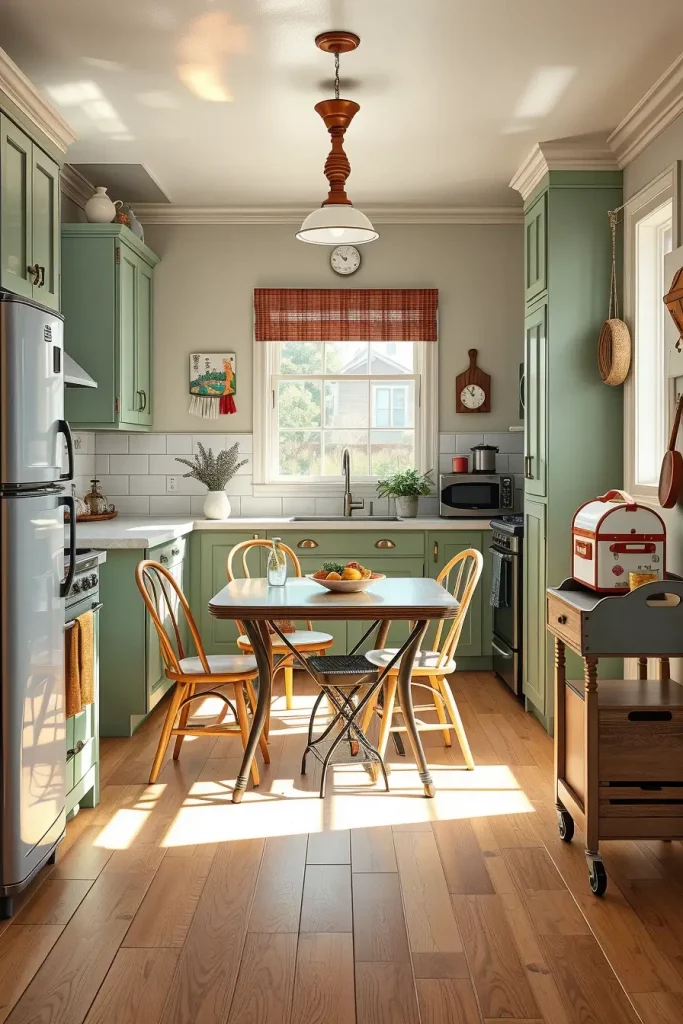
For furniture, it’s important to start small. A vintage wood table with turned legs, a mismatched set of dining chairs, or a mid-century sideboard can transform a kitchen’s vibe. I find that even swapping out modern bar stools for metal ones with patina can make the room feel like it’s all from a vintage era. Small details like enamel bread boxes or patterned fabrics work well in the theme.
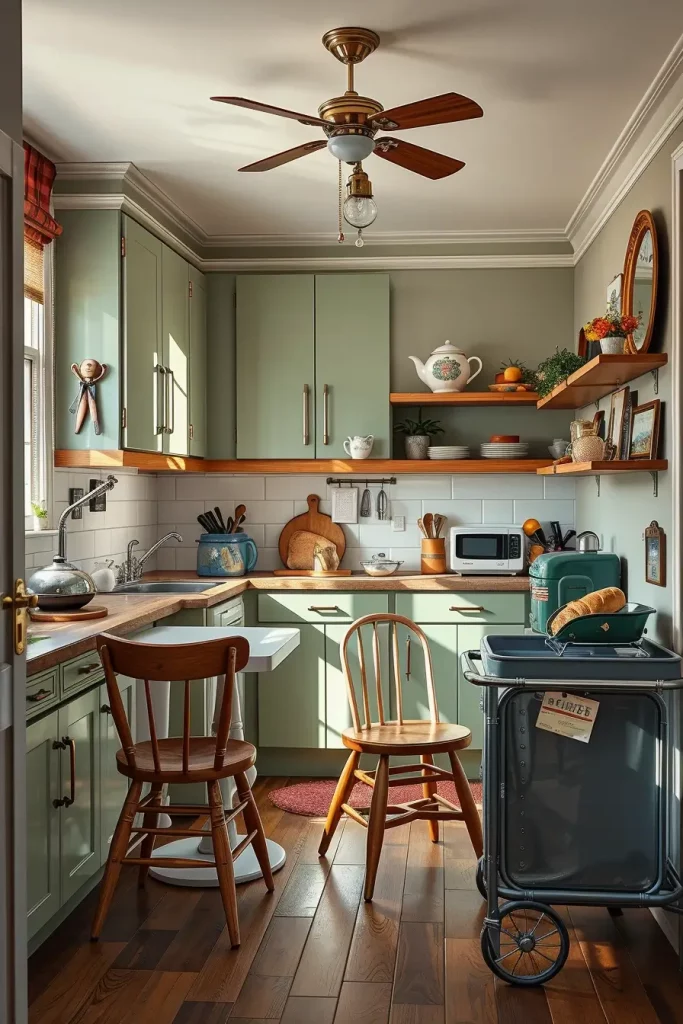
I’ve frequently suggested that clients take a phased approach – start with one key update such as new cabinet pulls, and build from there. Not only is this approach cost-effective, it allows the design to develop organically. Better Homes & Gardens often features layering inexpensive accents, reminding homeowners that “it’s not about buying everything at once but about building a look over time.”
What I’d like to add here is more about repurposing. I love to use reclaimed wood or an old dresser for storage instead of purchasing new shelving. These creative decisions not only lend authenticity but also affordability to the process.
Where to Shop for Thrifted Kitchen Finds
The hunt for the perfect pieces for a thrifted kitchen is an adventure in itself. Don’t be afraid to visit estate sales, antique stores, and local flea markets to find rare treasures. Online platforms like eBay and Etsy are also treasure troves for vintage dishware, lighting fixtures, and quirky accessories. Part of the fun is never knowing what you’ll find-a retro spice rack, a farmhouse-style sink or an old enamel table.
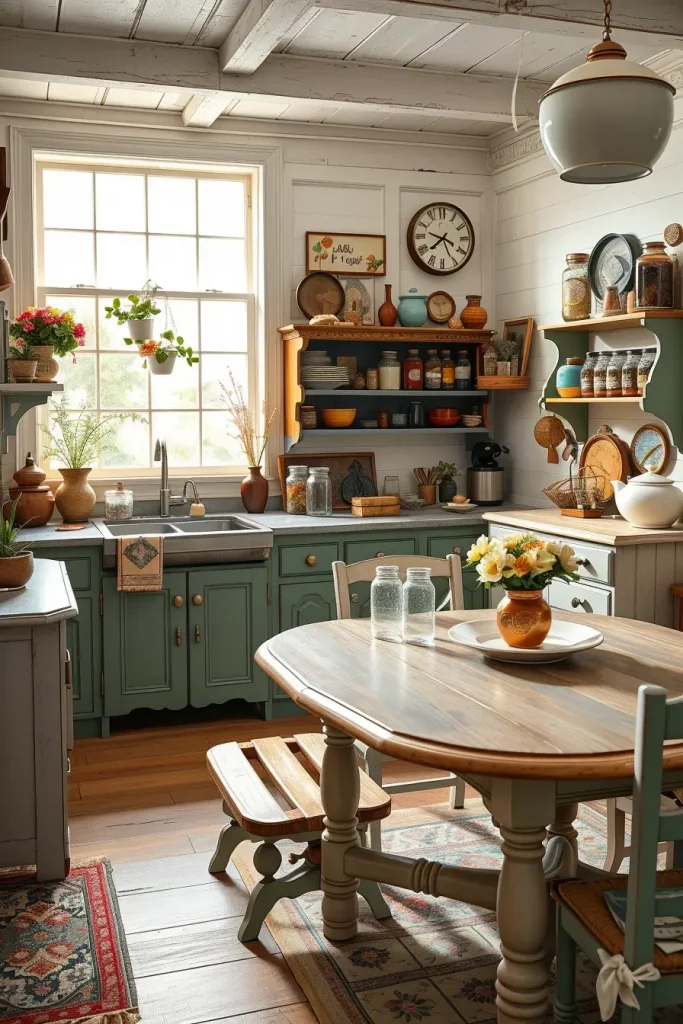
I think when it comes to design integration, it is important to purchase items that can be used in several ways. A second-hand sideboard, for example, can be used as both a storage unit and a statement piece. An assortment of old mason jars can be used for pantry organization and display. Every discovery can be character-building and practical at the same time.
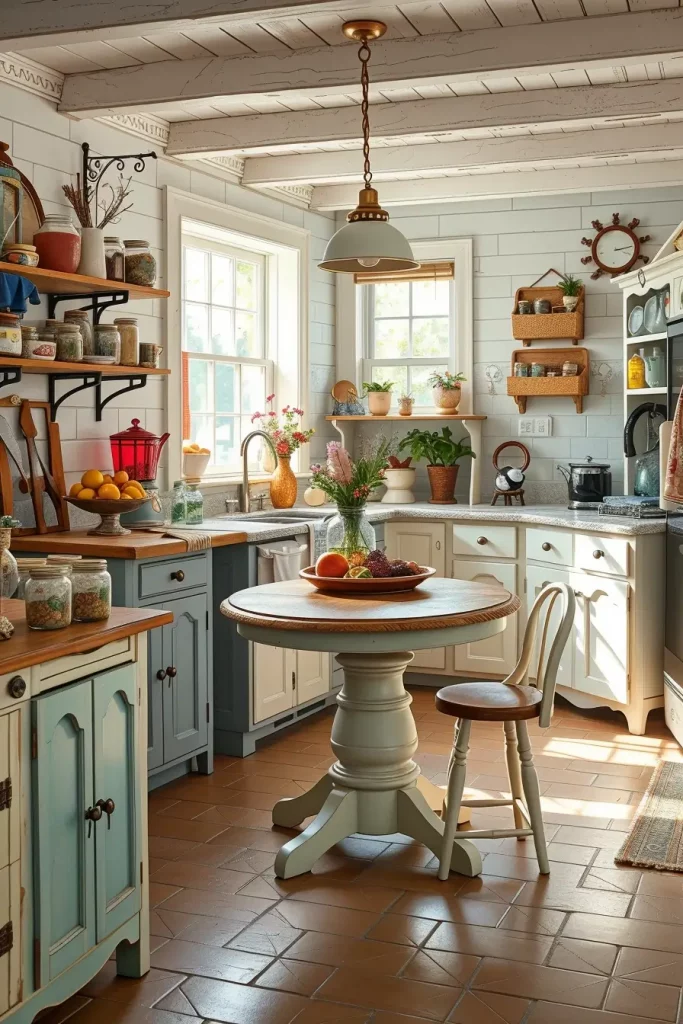
From personal experience, I’ve learned that patience is a must. Good pieces can be hard to find, but when you find them, the effect on the design is unparalleled. According to Apartment Therapy, vintage shopping is about “slowly, piece by piece, curating to tell a story, not just buying all of it at once.” This is true in all the projects I’ve worked on.
What’s missing here is a reminder to take measurements and photos when shopping. I have made the mistake of purchasing a beautiful cabinet that didn’t work in my space, and I’ve seen clients do the same. Being prepared will ensure your finds are ones that will truly enhance your kitchen and not cause clutter.
Mixing Modern With Vintage Elements
One of the most successful ways to create a successful vintage kitchen design is by mixing the old with the new. I find that the combination of modern appliances and thrifty or antique furniture works well. These light touches complete the palette and pull the look together.
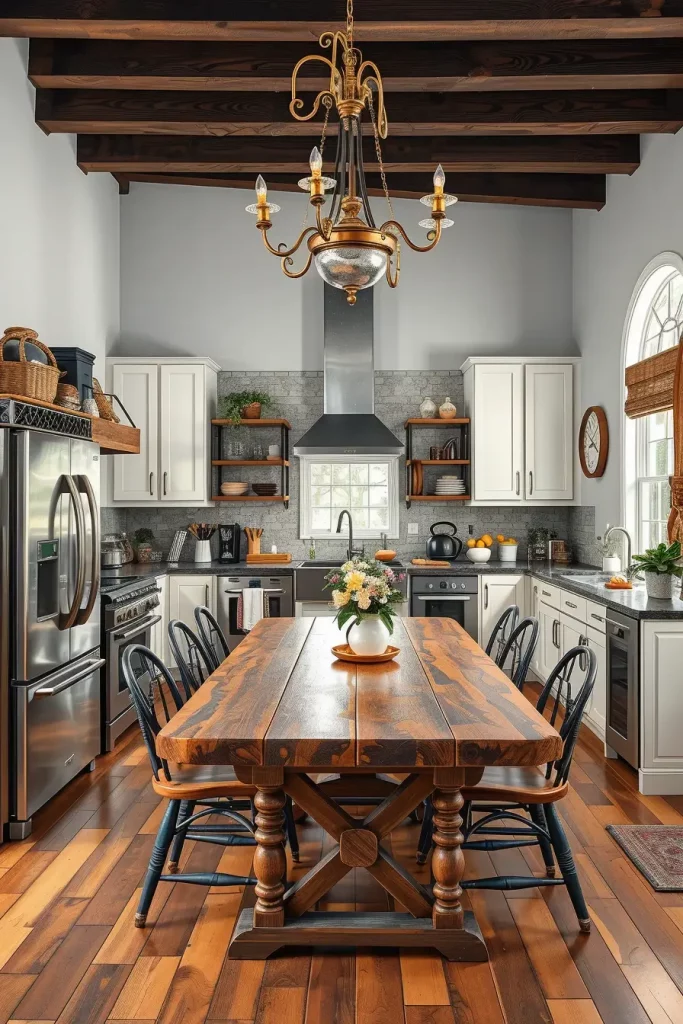
For furniture, I like modern cabinetry but vintage hardware or light fixtures. A vintage-style tile backsplash or a thrifted chandelier over a sleek island can help make the space feel timeless. Mixed eras keep the kitchen from becoming a theme park version of “retro” and instead make it feel lived-in and authentic.
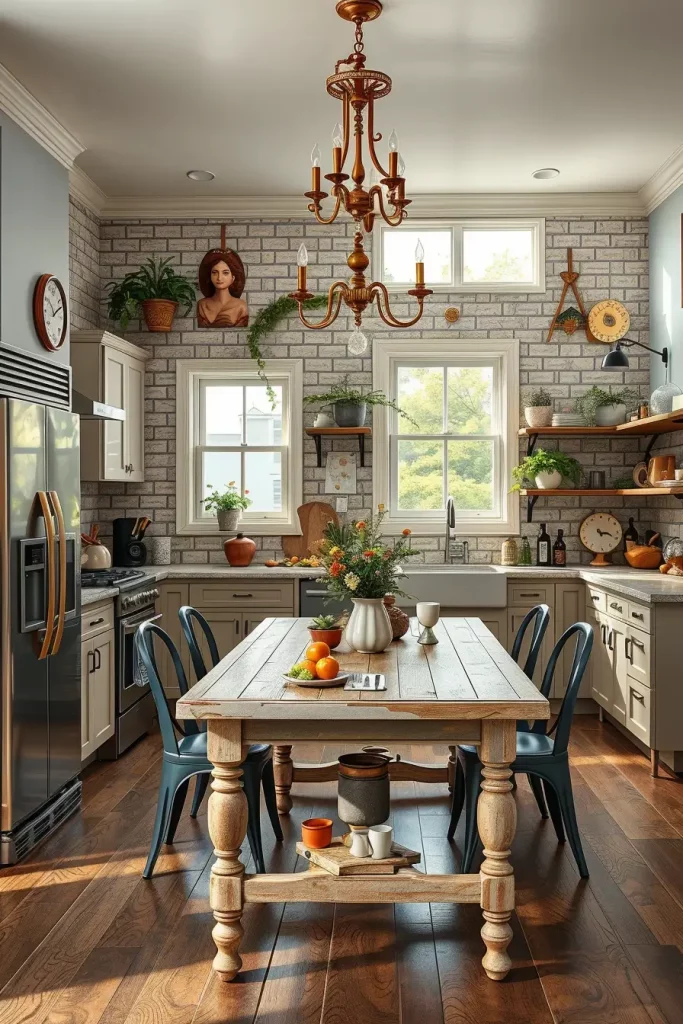
In my view, the best kitchens are ones that feel layered, not over-curated. I concur with Architectural Digest’s tips, which often stresses mixing design elements from decades together to create a cohesive look. This keeps a kitchen from feeling frozen in time.
I would recommend adding plants or textiles here to soften the look. A vintage rug under a dining table or some greenery on open shelves is a great way to bridge the gap between the past and present effortlessly.
Thrifted and vintage kitchens are not just a style; they’re a statement of sustainability, character, and timeless allure. By carefully selecting and layering, mixing old and new, and adding personal touches, anyone can create a kitchen that is warm and inviting. I’d love to hear from you – what old pieces have you used in your own kitchen? Let us know in the comments below and tell us your story!
